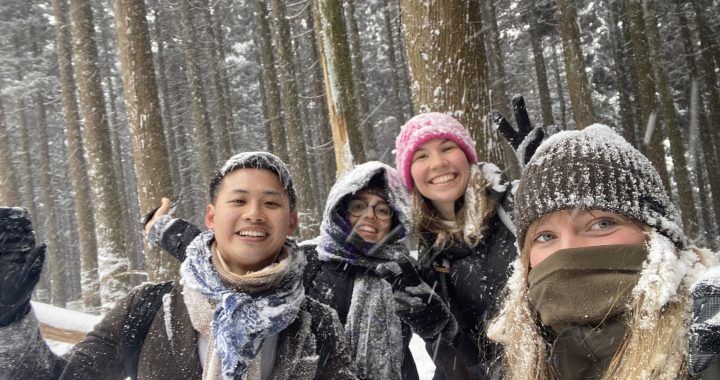I’d always heard the legends about winter being the “quiet season” for tea farmers—when tea bushes lie dormant and the fields, along with the tea tours, rest under the chill of the colder months. Well… my winter turned out to be anything but quiet. It was still very much genki—lively, bustling, and packed with exciting activities. In fact, I might even say it felt busier than autumn, thanks to all the tea-related shenanigans we dove into.

Nagoya Tea Festival: Chayoi
On the very first day of December, winter kicked off with a tea festival! Alongside Alix, Mac, Sara, and Marcello, I traveled to Nagoya in Aichi Prefecture to taste teas from across Japan—places like Ibaraki, Okayama, Kagoshima, Gifu, and so on. If you’re going to start the season, might as well start it right!



Kickstarter: Obubu Bus
This winter also brought one of my favourite collaborations of recent: working with former intern Sara Hagstrom on our second Kickstarter project. If you’ve already fallen in love with her vibrant mural next to Hojicha House, you’ll be glad to know she’s gifted us another Wazuka-themed masterpiece—this time on wheels! After her design was finalised, we all gathered to carefully apply the vinyl print onto our bus, which, as of March 1st, now runs between Wazuka, Kizu, and Kyoto.
During the winter months, part of my role—together with George, Sara, and Miwako-san—was managing the Kickstarter updates, promotions, messages, and later on the reward shipments. Seeing that bus now connect Wazuka to the wider world fills me with sincere joy. Here in Wazuka, we face challenges like a shrinking, ageing population and abandoned tea fields. I truly hope that the work we do at Obubu can help breathe life back into this place we love so much. Better transport links mean that tea enthusiasts and traditional craft lovers can visit more easily, supporting local artisans and businesses. And maybe, it will inspire the next generation to see the potential of building a life here instead of leaving for the big cities.
To everyone who supported our fundraising project: thank you! It means the world to us!
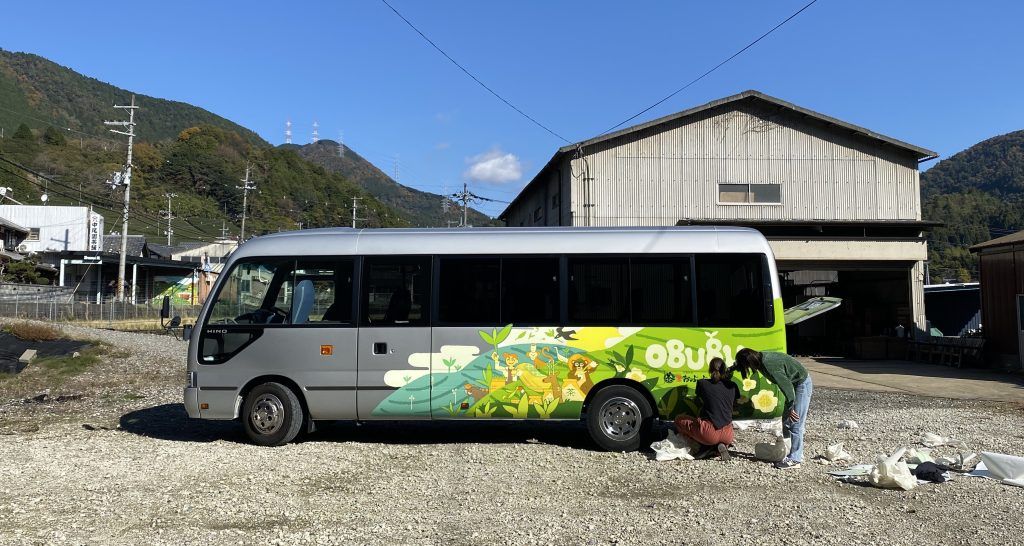
Learning to Change Car Tires
There’s no shortage of fascinating lore about Pau, and among his many talents, he’s also a certified car mechanic. So, Marcello and I were humbled to learn—straight from the master himself—how to change car tires. For a tea farmer navigating the steep, winding mountain roads of Wazuka, it’s an essential skill to have in your toolkit, just in case you find yourself with a flat in the middle of nowhere.
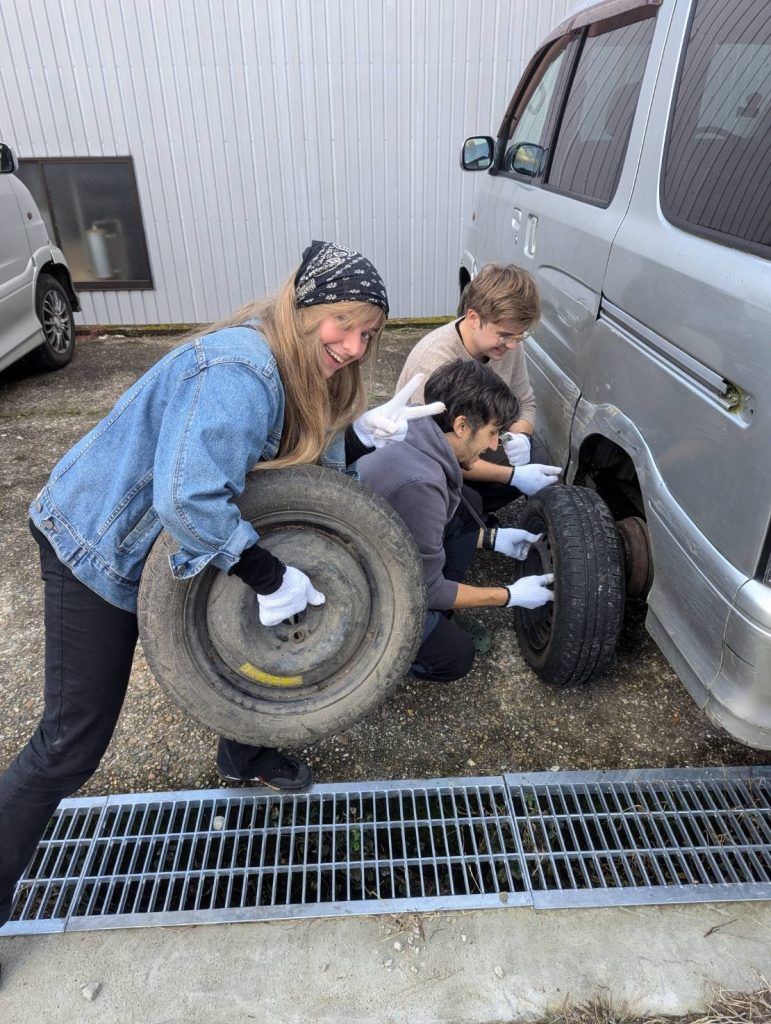
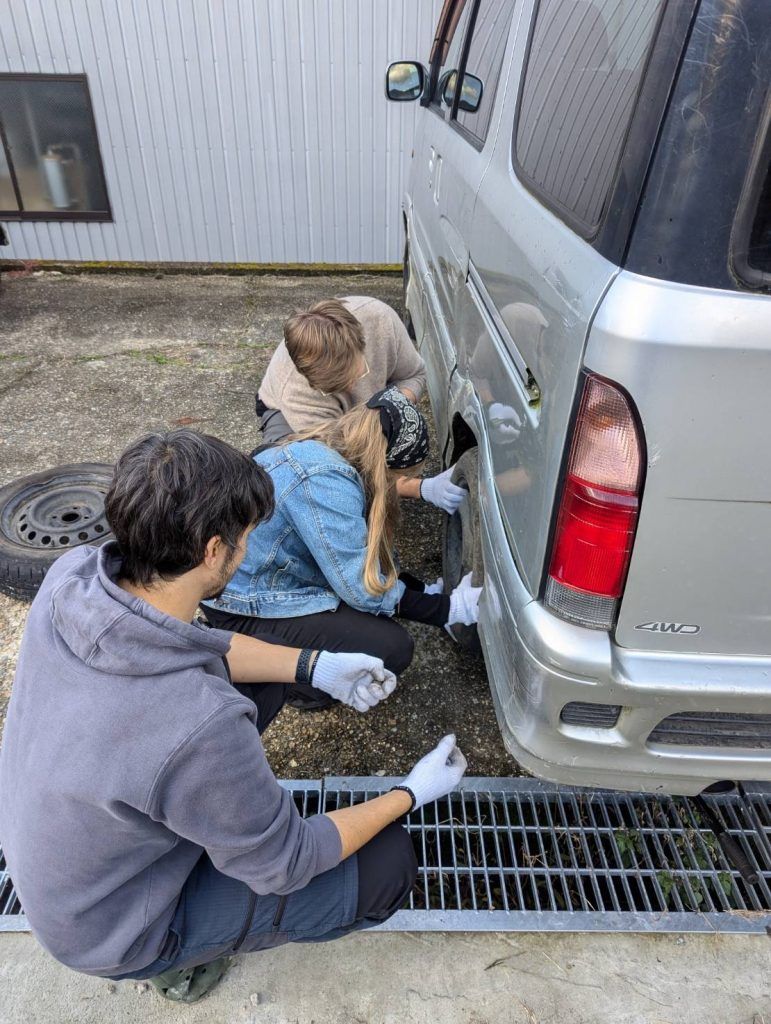
Winter Trimming with Akky-san and Miwako-san
Something I continuously keep discovering about myself is just how much I love being out in the tea fields, farming. And while harvesting is always a particularly thrilling venture, there’s something uniquely satisfying about trimming the bushes between seasons—caring for them so they grow well in the next flush, and keeping that iconic beautiful, rounded shape. Both harvesting and trimming demand intense focus: following the curve and shape of the bush with steady hands, cutting neither too deep nor too shallow, and keeping in sync with your farming partner’s pace while maintaining a good angle for the blade. There are so many subtle details to tune into—it truly feels like a dance!
That deep concentration could almost be compared to archery: the quiet discipline, the steady breath, the flow state you have to enter to achieve such poetic precision. This is why I love trimming. The crisp winter air and the occasional dusting of morning snow only add to the joy (especially as I’m writing this now in the sweltering heat of summer).
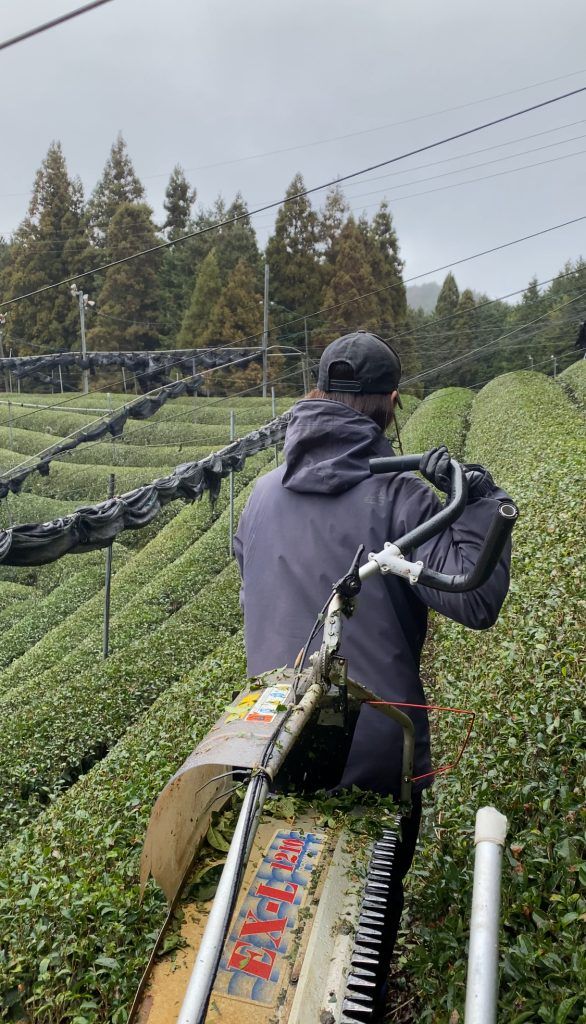




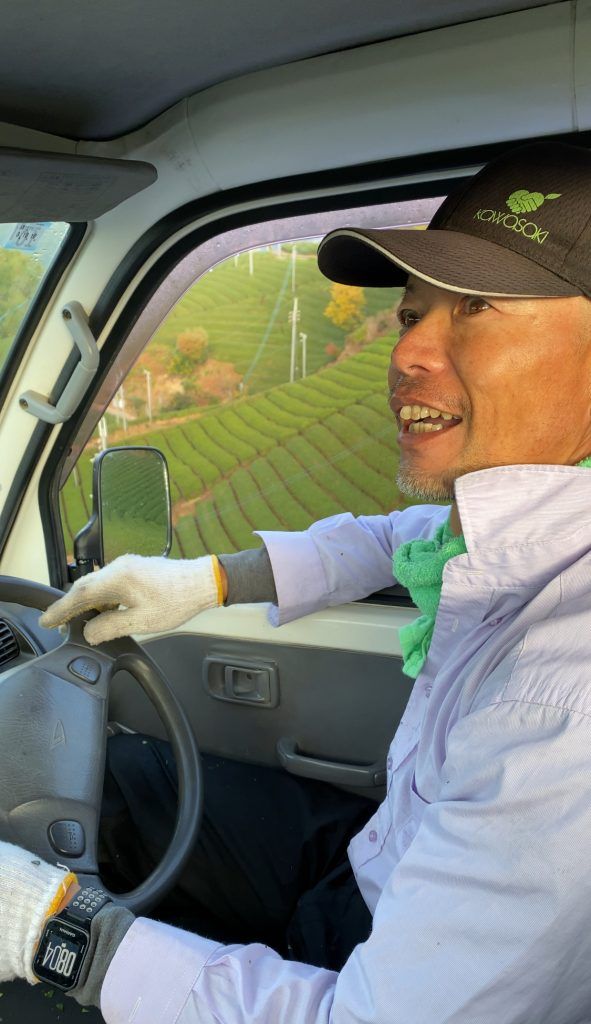
This winter was particularly special, with trimming quests alongside Miwako-san in Aoi Mori, and with Akky-san in his tea fields. We enjoyed plenty of cosy tea breaks—some even by a crackling bonfire built by Akky-san.

“Oops, the wrong mountain”
Winters in the Japanese countryside can be quite chilly—especially when you’re living in traditional housing (thank goodness for kotatsu tables, though). The cold means that people inevitably catch the occasional cold. Alix, my co-assistant manager and senpai, fell victim to one for about a week. Then, on a weekend when she was finally feeling better, she turned to me and asked, “Hey, Katrina, shall we go for a walk?”
Of course, I know plenty of nice walks. VERTICAL ONES. [evil goblin’ish laugh] Jokes aside, I had no idea the hiking trails around Mt. Kongō in Nara Prefecture would be quite as steep as they turned out to be, especially for such a modest altitude. I wouldn’t go so far as to call it a near-death experience, but we certainly joked about it enough on the way up. Survive the wild farming shenanigans at Obubu, and then try surviving one of Katrina’s weekend mountain “adventures” on top of that, will ya.
Any struggle was instantly forgotten the moment we reached the top and saw snow. Our excitement was uncontainable, we exclaimed loudly “Japanese snow!!!” as if it were somehow different from snow anywhere else in the world (the local hikers must have thought we’d completely lost it). Still, seeing our first snowfall in Japan became an instant core memory for both of us.
But that wasn’t the end of the story. My master plan had been to hike to the summit of Mt. Kongō. However, upon finally reaching the top, we looked at the sign and realised it said something entirely different. “Chotto matte… this is the wrong mountain.” So yes, we’d actually climbed Mt. Yamato Katsuragi instead—only realising this at the summit. Personally, I find that incredibly hilarious.

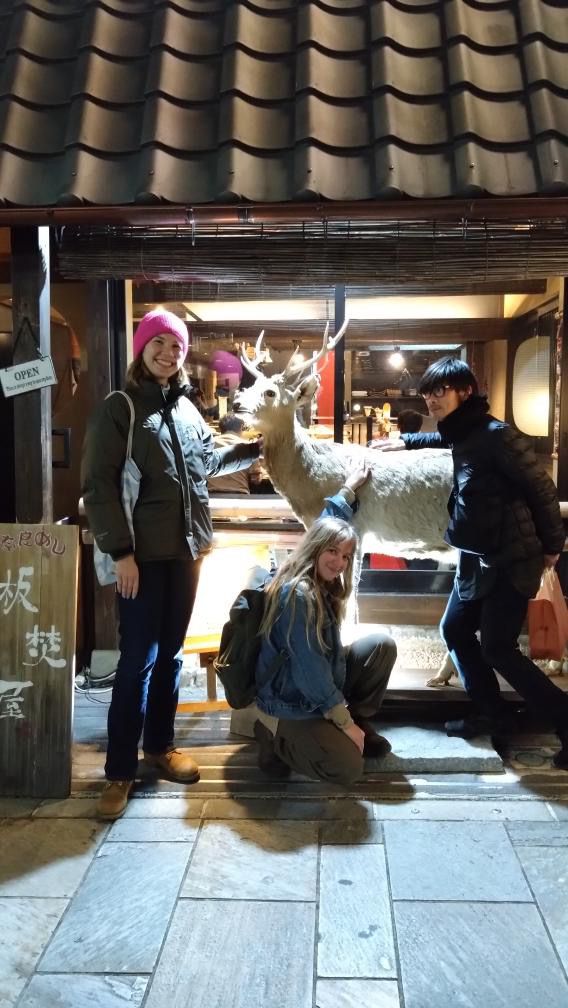

There, we enjoyed some Sonogi Tamaryokucha kindly sent to us by Marjolein from Ikedoki Tea in Nagasaki. The cool winter winds froze not only our hands but also chilled the water almost instantly—which, to be fair, worked rather well for brewing tamaryokucha. And in a lovely twist of symbolism, we later met up for dinner in Nara with Yuichi-san, whom I first met in Higashi Sonogi a year ago. Back then, Marjolein, Matsu-san and I had worked closely with him and the local town hall to promote Sonogi tea, so the evening felt like coming full circle.
Wisdom Tooth Removal
Hiro-san often says that an important part of the Obubu experience is the real-life adventures—not just the work-related stories, but the encounters with the world and its rougher edges, too. This winter, I was gifted a particularly unique opportunity: having my not-so-wise wisdom tooth removed in the Japanese countryside. Our ever-caring Kayo-san kindly helped me make an appointment with the local Wazuka dentist, Hayashi-san. You might wonder why I didn’t just go to a bigger city like Kyoto or Osaka—it’s not far, after all. Good question. My gut told me Hayashi-san was the right place for this. What could possibly go wrong? Having lived in the desert, I’d developed a deep trust in small-village skills—especially after once burning myself on a motorbike exhaust and having a local doctor heal me masterfully with beeswax. Different story, but worth mentioning, as it’s why I don’t believe that bigger cities equal better skills.
That said, I’d be lying if I claimed I wasn’t anxious about the whole thing. During an intern meeting, George gave me the warmest, most reassuring pep talk, telling me it would all be fine. On the other hand, when Miwako-san heard I was having it done in Wazuka, she burst out laughing and exclaimed, with sarcasm, “Ganbatte ne!”—two very different ways to comfort a worried friend, but both oddly effective.
The comedy continued on the way to the clinic, as Kayo-san played “Let’s Groove” by Earth, Wind & Fire in the car—a questionable yet hilarious soundtrack choice for impending dental surgery. Once the procedure began… well, it wasn’t exactly pleasant. The doctor struggled quite a bit, and to my surprise, I kept hearing him mutter “yaba-”, “deka-”, and “suge-” mid-operation. Apparently, Japanese wisdom teeth are usually much smaller than mine, making this an unusual challenge for him. So there I was, lying in the chair with my mouth stretched open, someone wrestling out a tooth while providing a running commentary in funny Kansai-ben. I honestly wasn’t sure whether to laugh or worry—“Wait… is this actually yabai?”
Thankfully, it all ended well. Back at the office, we admired the big “trophy” and joked that it should be turned into a necklace and offered as a Kickstarter reward (sadly, it was not—sorry). And so the saga closed with me losing some of my wisdom and, later that evening, singing “Dancing Queen” by ABBA in the Obubu House kitchen, looking like a very puffy-cheeked hamster and still slightly high on anaesthesia.
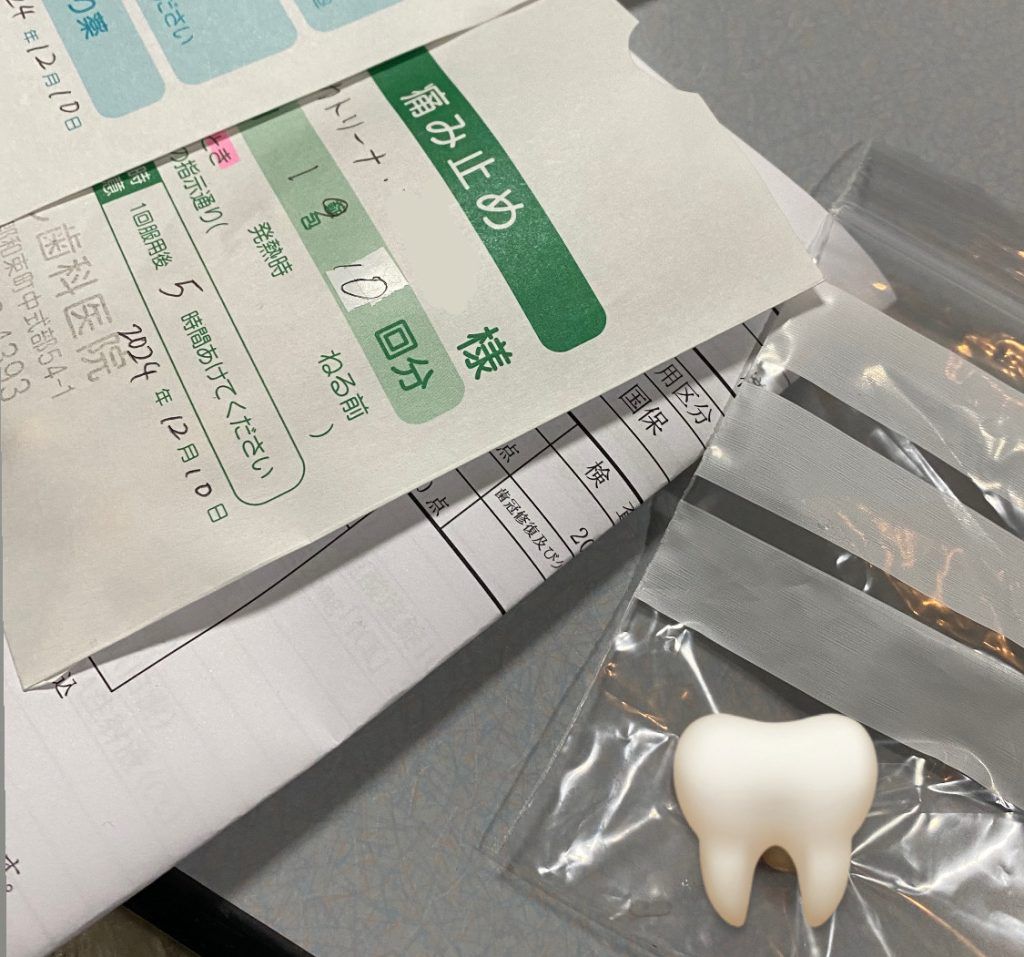
Tokushima: Kamikatsu Awabancha Festival
On 14th December, we had the pleasure of travelling to Kamikatsu in Tokushima Prefecture for the Awabancha Festival. The event was held near the famous “Why Kamikatsu” recycling centre. Although Awabancha production takes place in summer, around August, the December festival celebrates this rare tea—giving us the chance to meet its makers and taste the results of their craftsmanship. Kamikatsu is also renowned for its zero-waste initiatives and, like Wazuka, is listed among the 100 most beautiful villages in Japan. No wonder—the surrounding mountains, forests, and rivers are truly majestic.


During the trip, we also stopped at the Ai no Yakata historical indigo-dyeing museum, located near Tokushima City. Indigo dyeing has a long tradition in the prefecture, and we even tried our hand at it—briefly dyeing tenugui and bandanas in that deep, iconic blue.
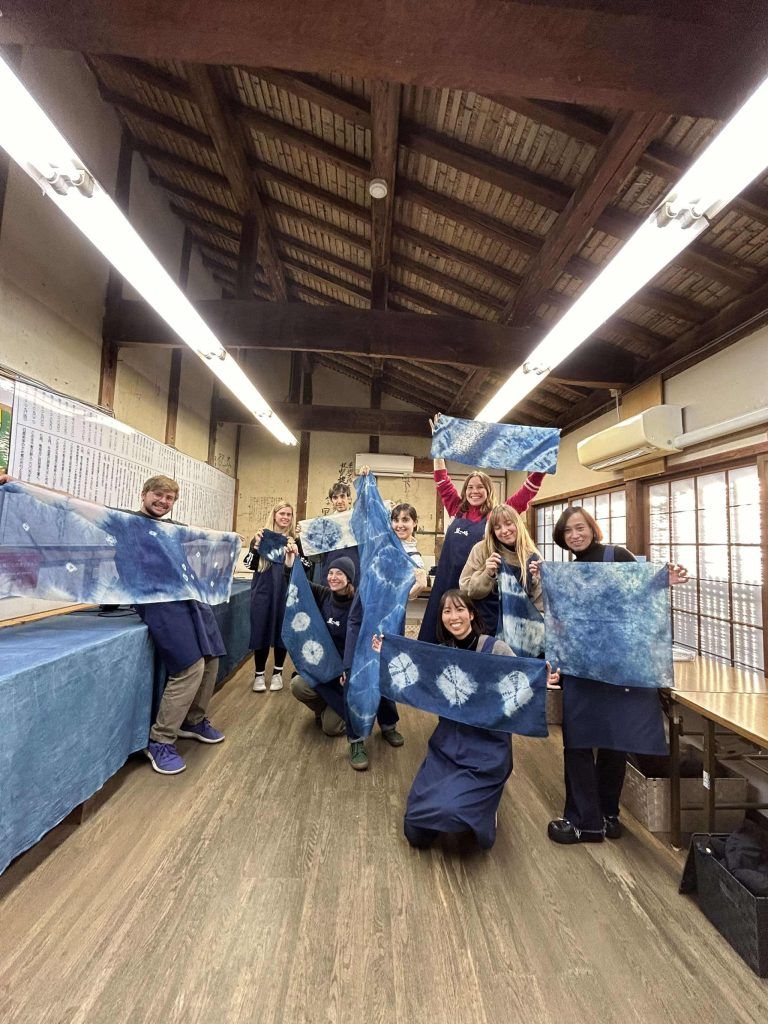
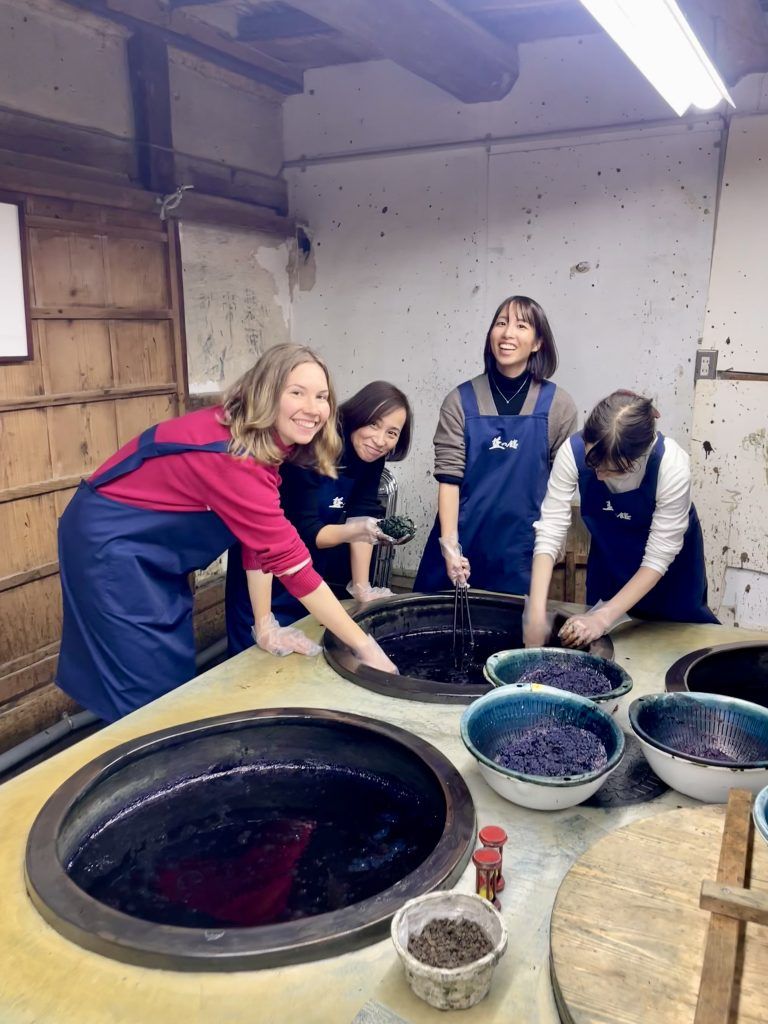
And of course, there was tea in nature! This time, our outdoor tea break was near the Amagoi Waterfalls in Kamiyama, accompanied by Lord of the Rings conversations while sipping Miyazaki Sabou’s Minami Sayaka wakoucha. After a short hike along a mountain stream and forest path, we arrived at the beautiful, 45-metre-high waterfall. For centuries, farmers have come here to pray for rainfall to prevent drought and secure a good harvest. I suppose we, too, have prayed for a plentiful upcoming shincha season.
Shikoku is well known not only for its fermented teas but also for its citrus fruits like mikan and sudachi, its Naruto kintoki sweet potatoes, the dramatic whirlpools of Naruto, and the island’s famous 88-temple pilgrimage—on which we visited Ryōzen-ji Temple.

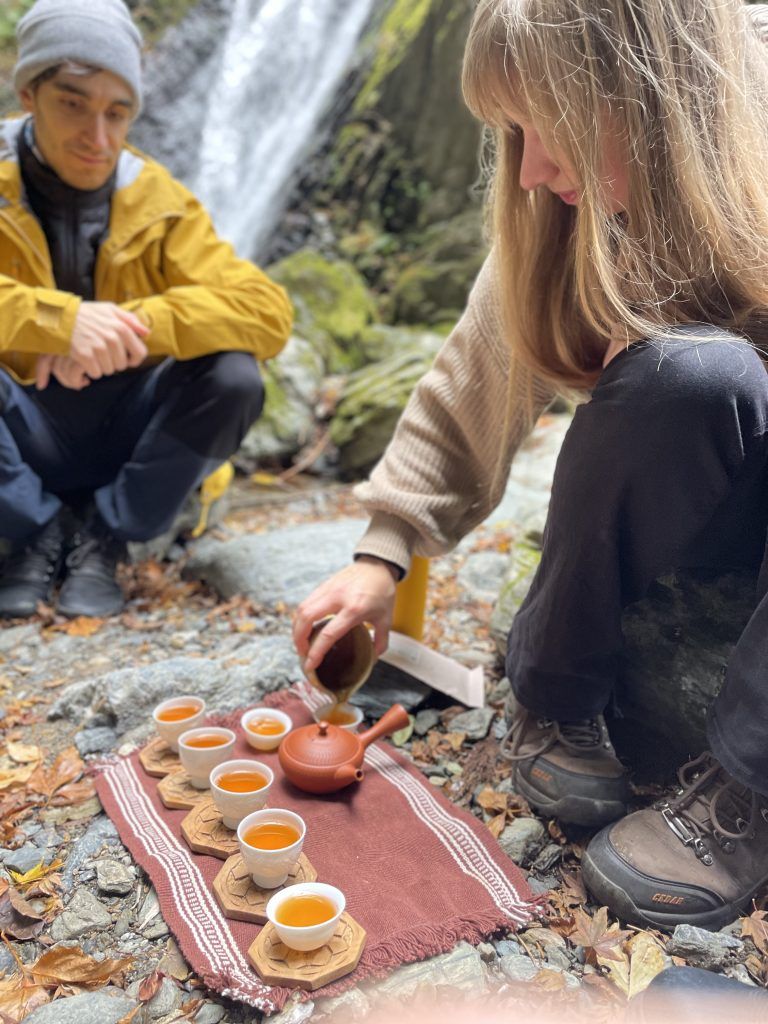
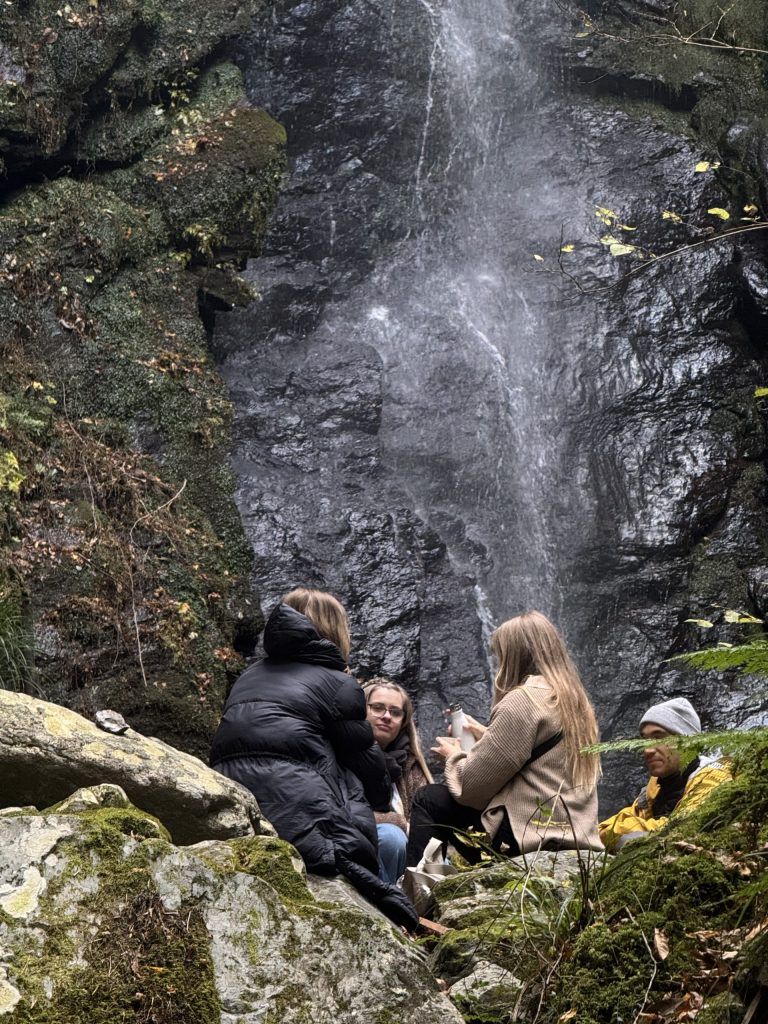
AME: Assistant Manager Education
As an intern at Obubu, you take five lessons on Japanese Tea Basics (JTB). But as an assistant manager, you dive into thirteen in-depth lectures known as AME—covering every facet of Japanese tea: history, processing, farming, biology, chemistry, evaluation, cultivars, tea ware, and more. These lessons were masterfully designed by former AMs Jean, Sarah Mazza, and Pau, and truly feel like university-level courses on Japanese tea.
Obubu Ambassadors are welcome to join these sessions live via Zoom, and they also have exclusive access to the recordings—so they can continue learning long after graduation. I was fortunate to study them myself during winter, taught by my wonderful senpai Alix and Mac. Now, in August and September 2025, the current assistant managers are learning from Pau, George, Miwako-san, and me.



Turkish Tea Farmer Visit
Tea, as always, has a way of bringing people together in meaningful ways. This time, we had the joy of hosting my friends from Türkiye—tea farmers and ceramists from Rize. Together with Akky-san, Natsu, and Sato-san, we welcomed Yuchi of Chaynik Tea, Ayşe and Hatice of Bozayı Fırtına, and Aytül of Tea Chef to Obubu. We shared both Japanese tea and Turkish tea brewed in a kyusu—transcending borders, one teacup at a time. After exploring Wazuka, we visited several tea shops in Uji, including Horii Shichimeien, Kanbayashi, and Baisa Nakamura. I truly believe there’s something magical about farmers visiting farmers: the exchange of knowledge, the spark of ideas, the cross-pollination of innovations that can be carried back to our own tea gardens and countries. So much inspiration! Similarly, in autumn we welcomed Georgii from Zemo Tea Gardens. Encounters like these feel incredibly special, and I hope we see many more of them in the future.

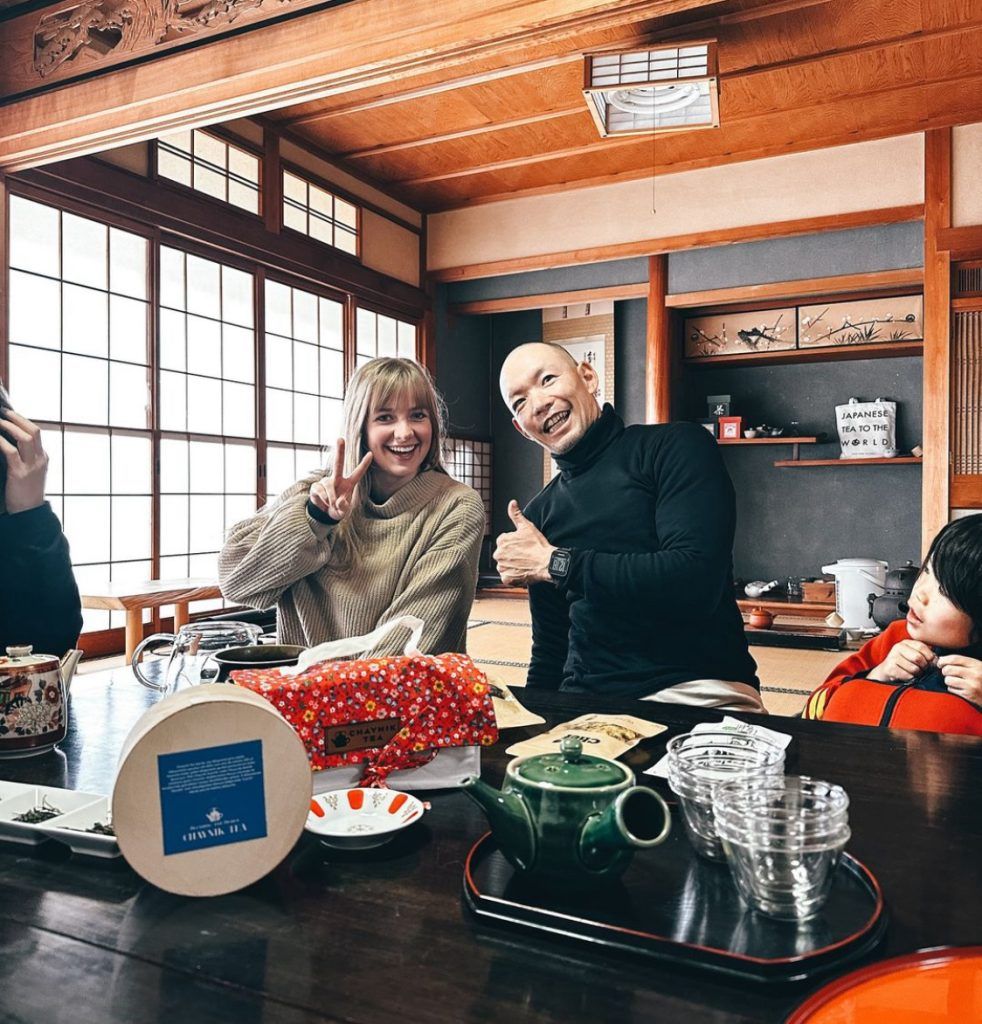
Christmas Celebrations
The holiday spirit was in full swing this year at Obubu. Kayo-san and Miwako-san dressed as Santa, while Akky-san and I took on our reindeer roles. We enjoyed a lively Secret Santa exchange, brimming with creativity and surprises, and decorated our Christmas tree together. For Christmas dinner, the assistant manager team prepared a feast of traditional dishes from our home countries: Italian mushroom risotto from Marcello, winter salad by Mac, and a French tarte tatin with cheeses from Alix, and Latvian potato salad by your little potato.
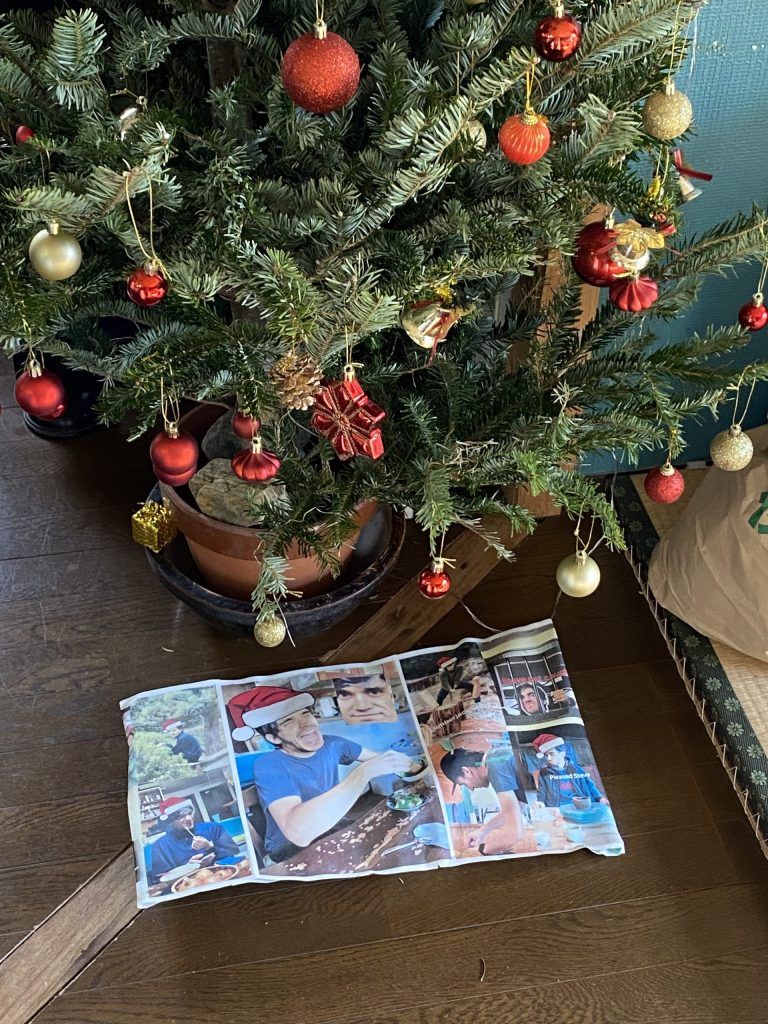
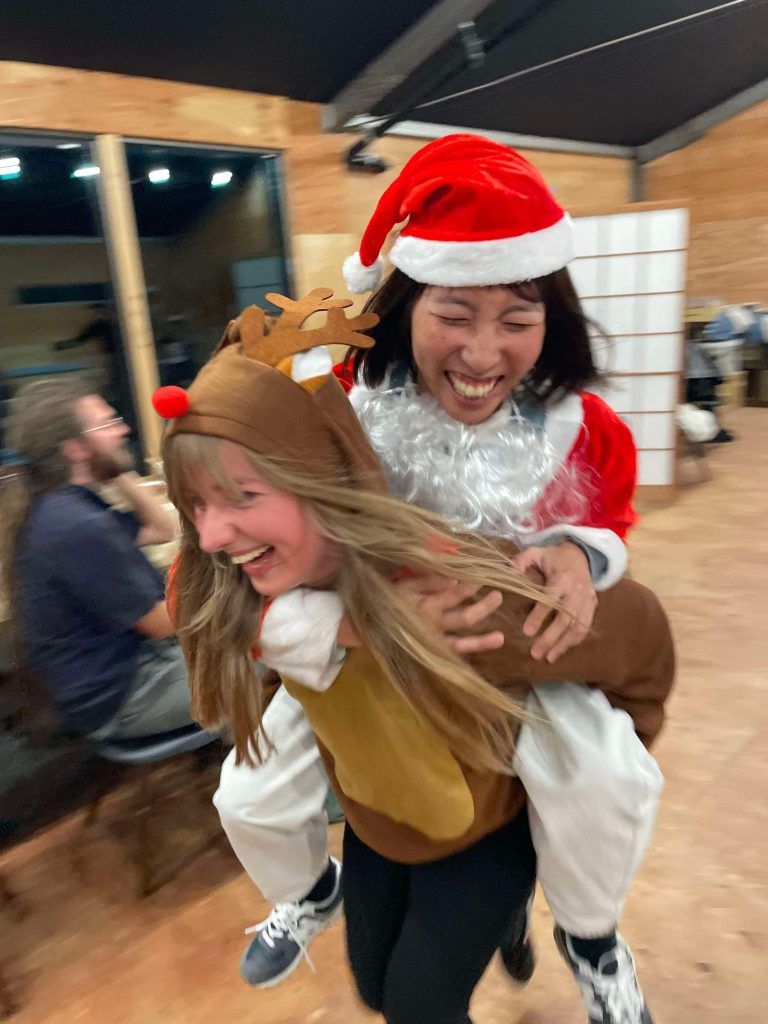
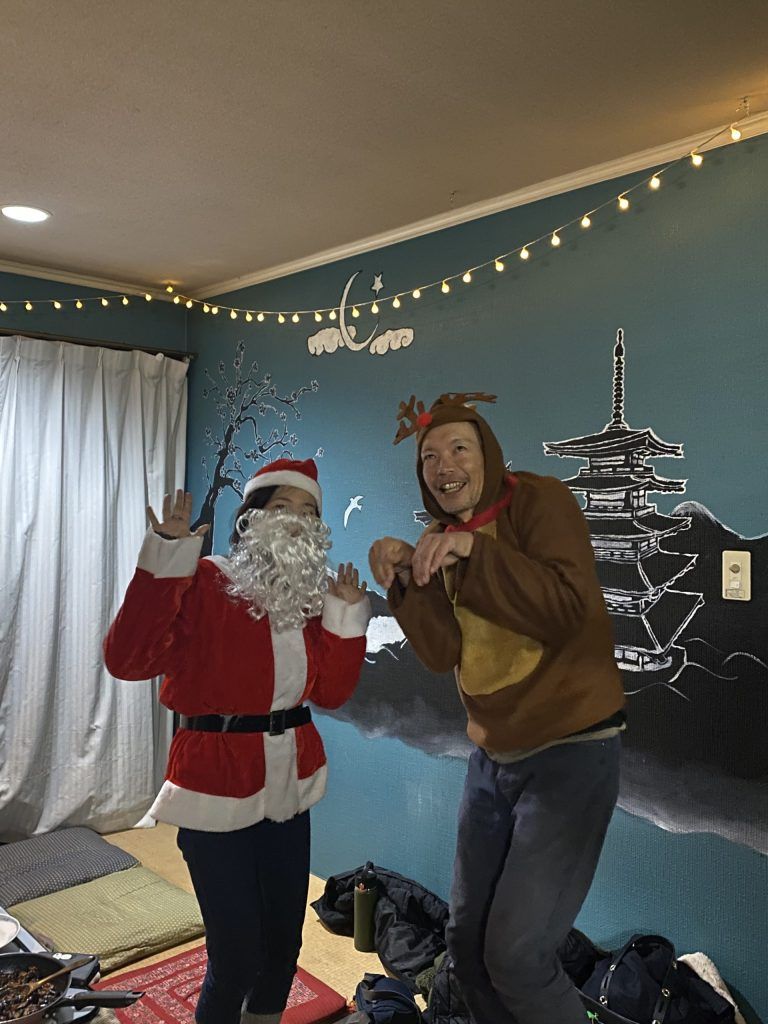
T-magazin Feature
Obubu and I were recently featured in several editions of t-magazin, both German and International. The Japan issue includes an article by Olaf Tarmas and me about caffeine in tea, while the tea travel edition published a piece on my long-term tea expedition across Asia. Obubu also appears in an article by Maria-Bettina Eich, who visited us on a tea tour. Her article offers an insightful look at tea tourism in Japan, describing Obubu as a pioneer in the field. She also highlights Ikedoki Tea, Obubu’s sister company in Nagasaki.


Shoji Paper Renewal in the Tea Room
As part of the Japanese year-end cleaning tradition, osouji, we renewed the shoji paper in the tea room where we host our tea tours. Naturally, it wasn’t without a bit of mischief. George came up with a fun idea for a short Jackie Chan-style filming extravaganza: one person punches through the old shoji paper while another throws a kyusu to catch it. We did sacrifice one kyusu in the process, but as true tea ninjas, I’d say the mission was a success in the end.
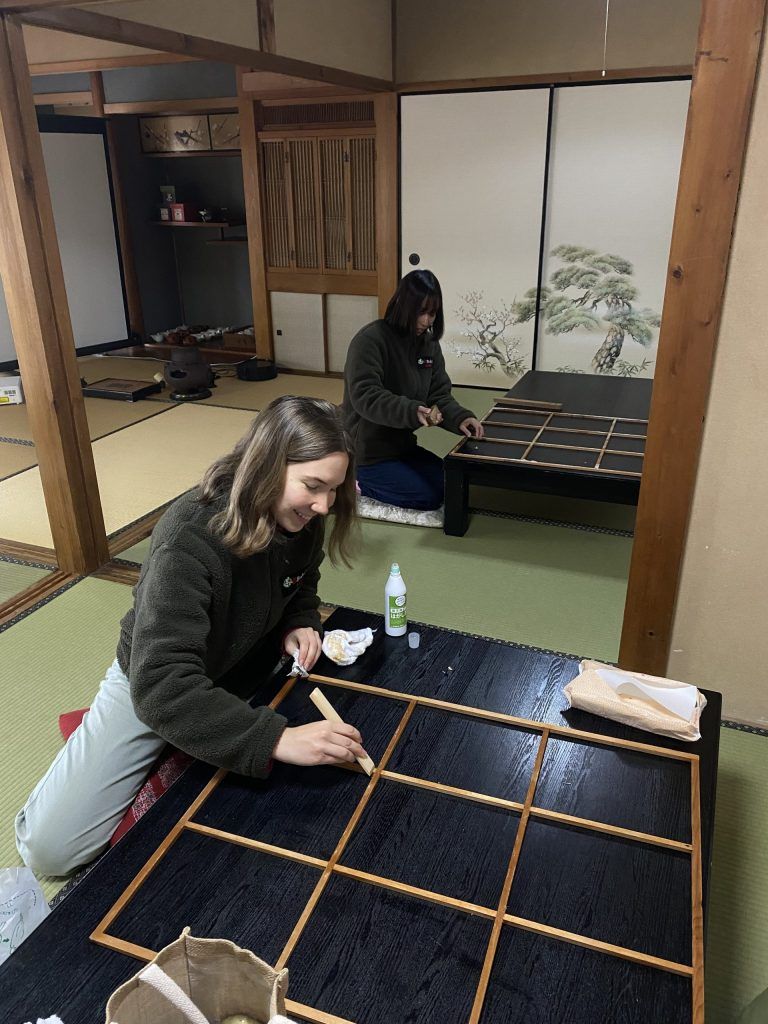
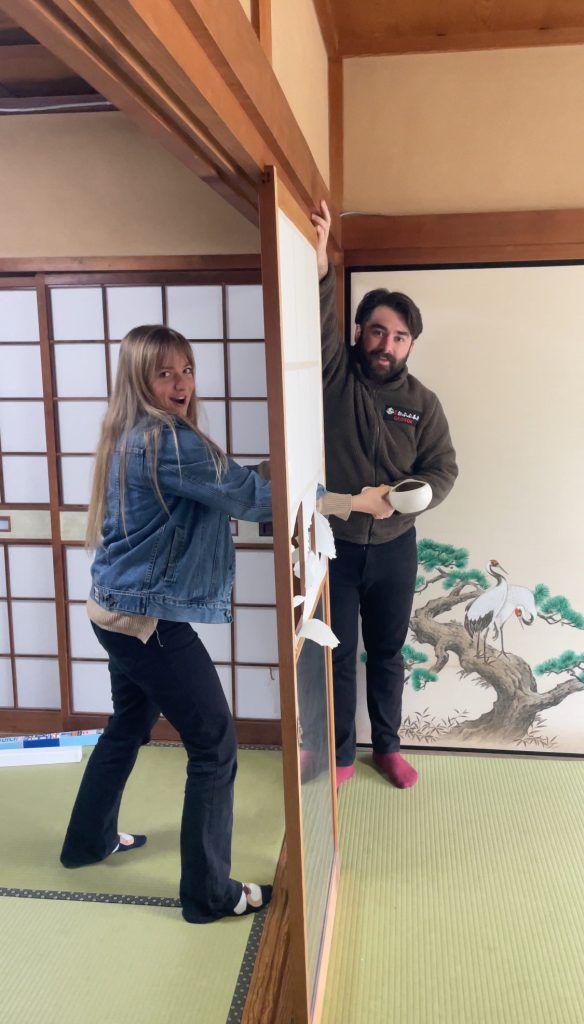
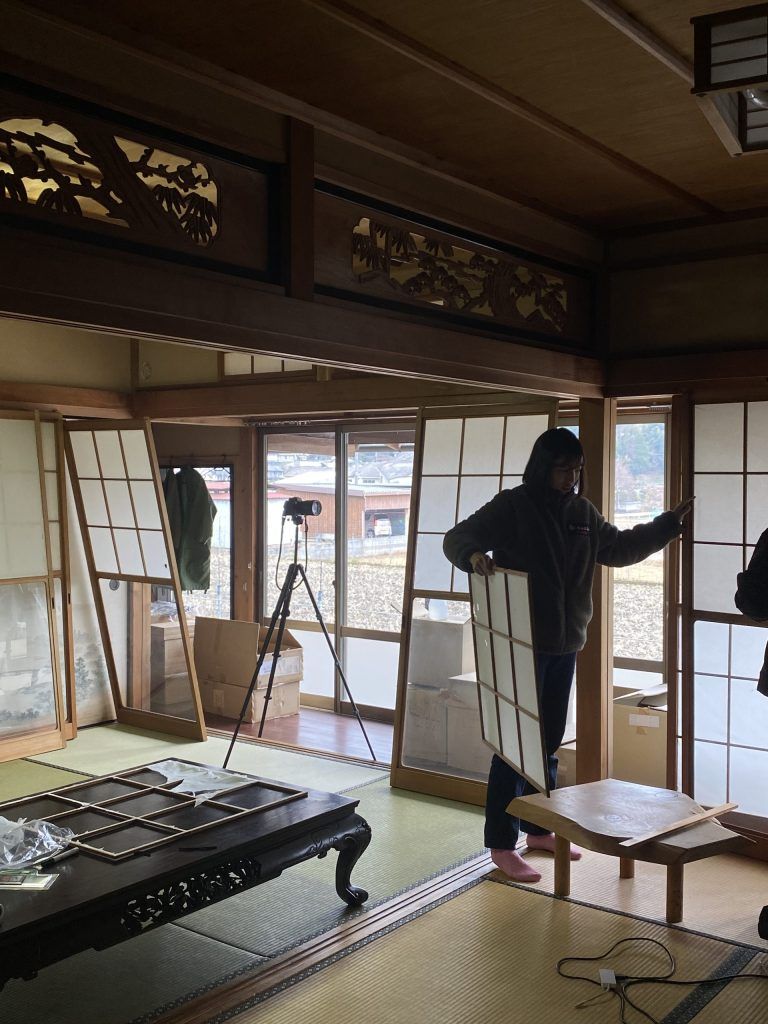
New Year Hike
In Japan, New Year includes several special traditions to mark the new beginnings. I enjoyed toshikoshi soba (年越し蕎麦) with smoky kyobancha at Kyoto’s oldest restaurant, Honke Owariya (1465), a New Year tradition symbolising longevity and severing hardships of the previous year. From Nijo Castle, I strolled through Kyoto Gyoen to Shimogamo Shrine for my first prayer of the year (hatsumode; 初詣), where a tall fire burned brightly near the torii gate. Pulling omikuji (おみくじ; fortune) and enjoying shrine’s warm amazake (甘酒) to welcome 2025. New Year in Japan celebrates plenty of “firsts” (hatsu; 初), like the first prayer and sunrise (hatsuhinode; 初日の出). Thus, I wanted to do a first hike of the year meeting the first light. I hiked Atagoyama (愛宕山) near Arashiyama in Kyoto, witnessing komorebi (木漏れ日; sunlight leeking through trees), praying at the mountain shrine, having a bit of shrine’s sake, spotting plenty of bear signs on this solo venture, encountering a monk hiking up barefoot, sipping sencha on the snowy summit, and tencha by Katsura River. Thanks to George’s Christmas gift, the camping stove, this adventure was made possible (we are inseparable now, I go everywhere with this stove). Descending via Tsukinowa Temple (月輪寺), I even met a deer, adding to the heavenly atmosphere. Later, I had to visit Kōzan-ji Temple (高山寺), home to Japan’s first tea garden, where Myoe planted tea seeds in early Kamakura period gifted by Zen priest Eisai, who brought those from Song China. This finalised the very special mountainous tea solo pilgrimage. And despite 3 hours of sleep and walking nearly 40 km in these 24 hours, I felt as refreshed and fulfilled as ever, ready to take on new challenges this year. I’m still yet to try obukucha (大福茶; “good fortune tea,” green tea, dried konbu, ume, and sprinkle of gold).
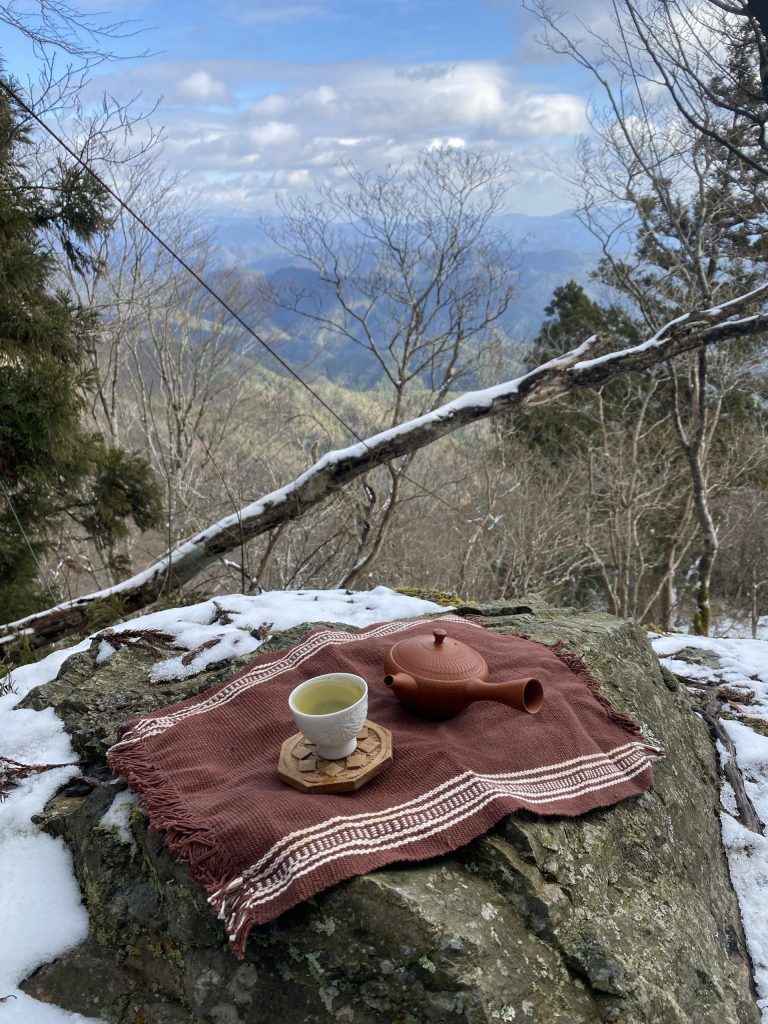
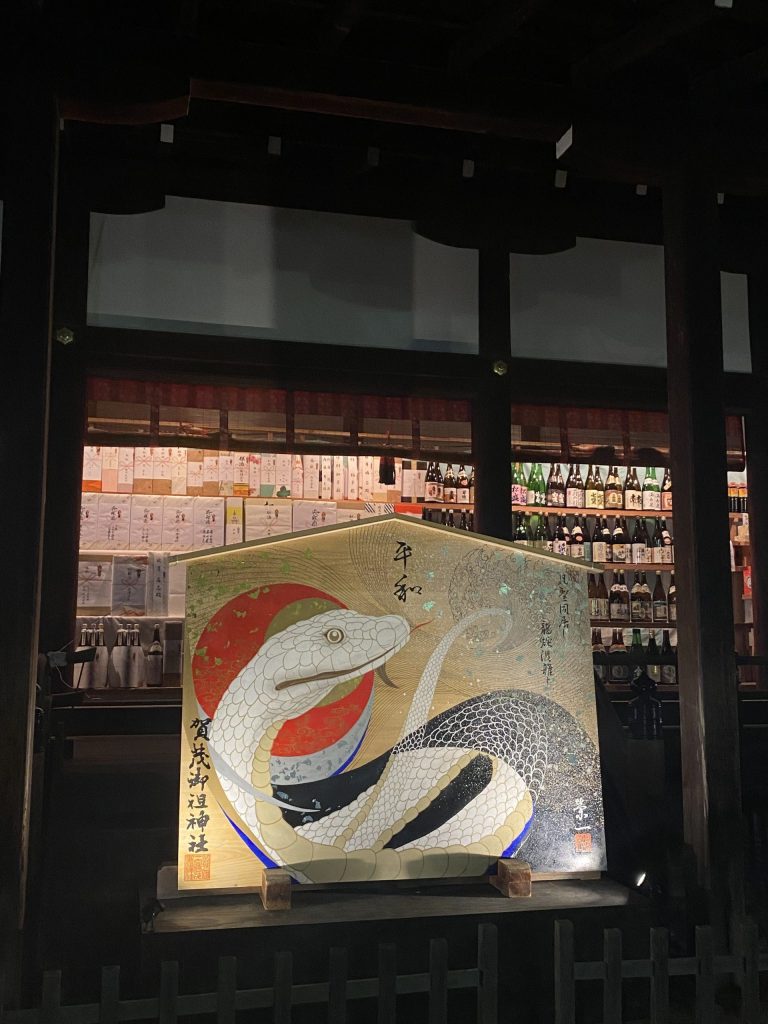
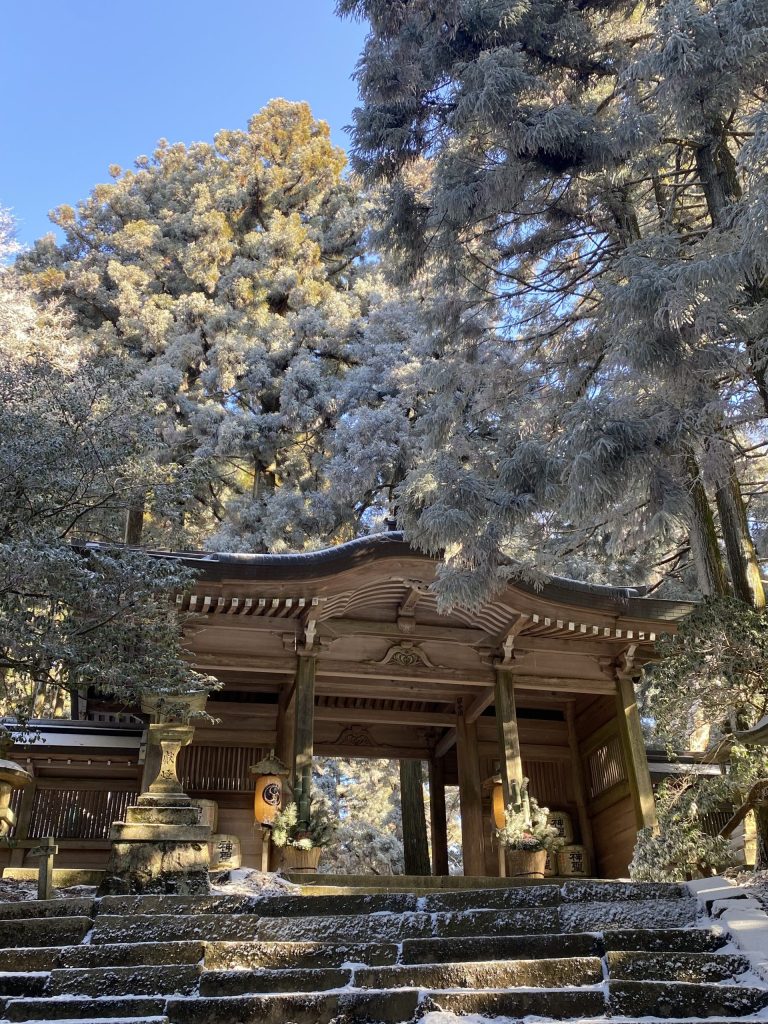
Baisa Nakamura
Following in Pau’s footsteps, I began volunteering at Baisa Nakamura tea studio in Uji to deepen my understanding of temomi and machine processing of sencha before the spring harvest, as well as to serve sencha to both international and Japanese customers. I first met Eiji-san in autumn 2023 while volunteering at Obubu during renovations on the second floor of the sencha factory. It was a series of beautiful coincidences—from meeting his senpai Genki-san of Tea Factory Gen from Hiroshima in Taiwan earlier the same year, to writing an article about his innovative space, and finally to helping out on weekends from time to time.
It’s such a special place, filled with lovely, knowledgeable people. Every visit feels like a new learning experience. The leaves are harvested, steamed, and frozen every spring, allowing the tea shop to process fresh ichibancha sencha all year round, right in front of you, in small batches. For those who don’t work with tea, it’s rare to witness a tea factory in action, making this truly a unique spot. If you’re travelling to Uji, this is definitely a must-visit place!
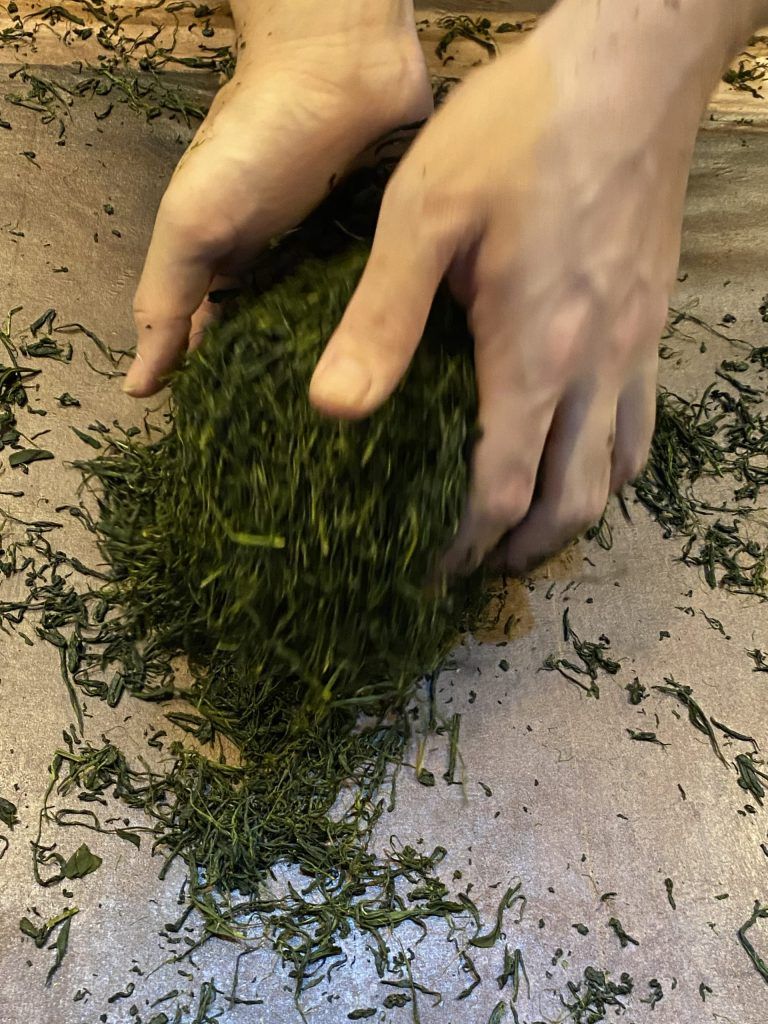
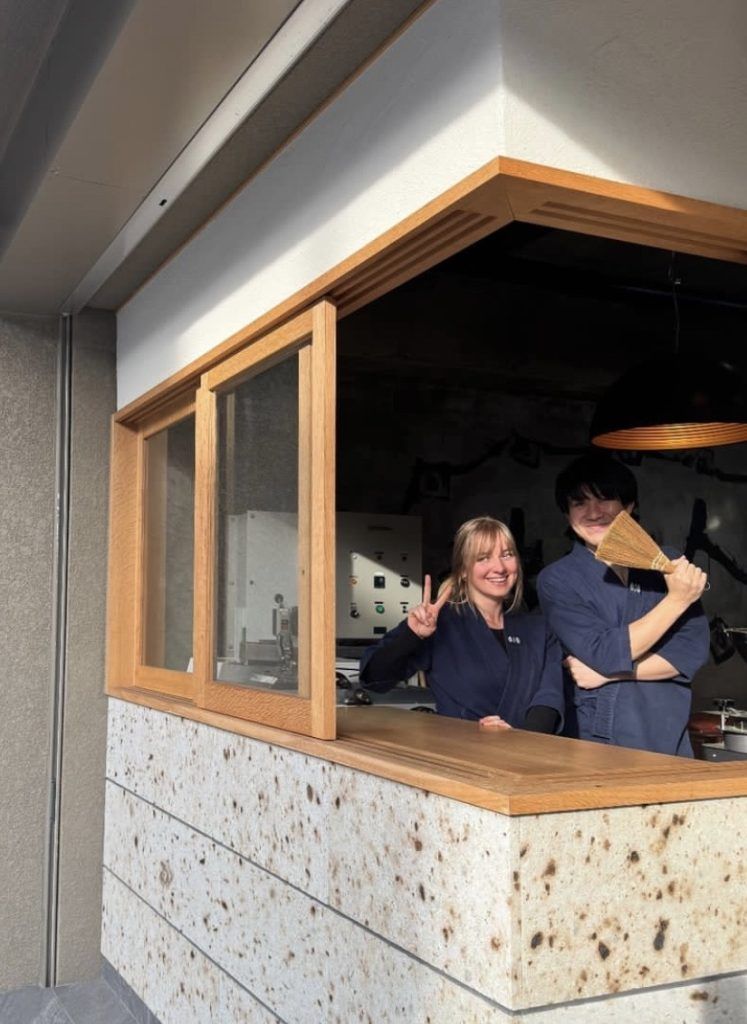
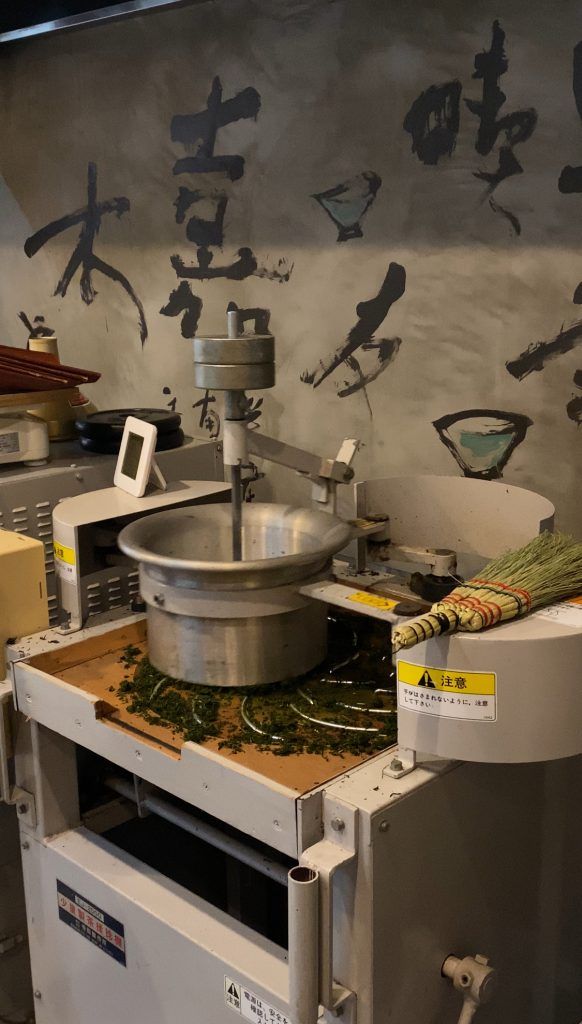
Abandoned Tea Field Regeneration in Monzen
One of the winter projects was also the regeneration of an abandoned tea field in the Monzen area of Wazuka—an area you’ll pass on the way to our tea tour field. This field, a 100-year-old Zairai treasure, had become a “tea jungle,” and we’ve begun the journey of bringing it back to life! Despite only two years of neglect, the tea bushes had already grown to towering heights of around 2-3 meters! Trimming these bushes was no easy feat— it was a full-body workout we jokingly called “swimming through a sea of tea.” Thankfully, with sturdy machines and sheer muscle power, we made it! Abandoned tea fields like this are sadly common in Wazuka due to the challenges of an ageing population and younger generations leaving for the cities. However, we hope that the situation improves little by little, and that we can contribute to a positive change one bush at a time. Recently, we also had a naming competition for this new tea field among our Tea Club members, and former intern Lourdes, ended up naming this field Inari! It has a beautiful Inari shrine right next it after all! Once it recovers after the deep cut and millions of weeding sessions, we will start producing Natural Series Teas here, just like Aoi Mori.


First Snow
The first snow of the year finally arrived, and even though it didn’t stick around for long, it was a beautiful sight while it lasted! Waking up to the tea fields lightly dusted in white was a treat, and despite the freezing temperatures, everyone was excited, snapping plenty of photos before it disappeared.
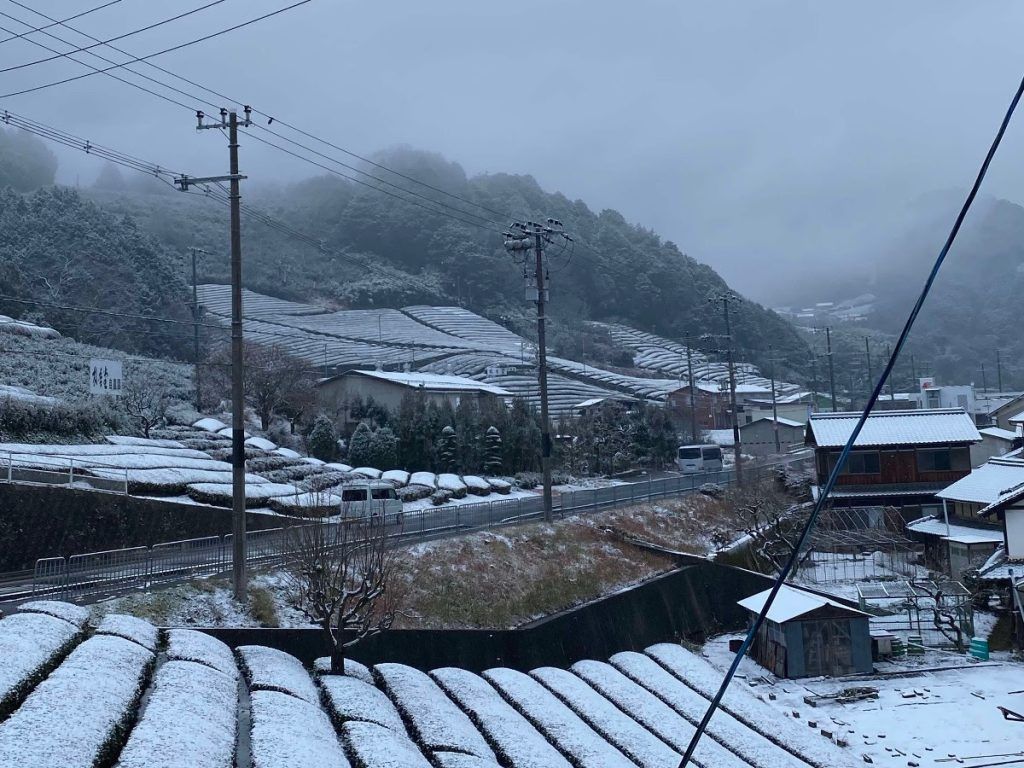
Nabe Festival in Kasagi
Winter in Japan definitely means plenty of naps under the heated kotatsu table—and, of course, hearty, warming hot-pots known as nabe! Luckily, the nearby village Kasagi famous for camping and beautiful outdoor activities also hosts a nabe festival. The local specialties include pheasant and wild boar hot-pots. This winter, Obubu House was no exception, witnessing many cosy nabe evenings filled with delicious food and good company.
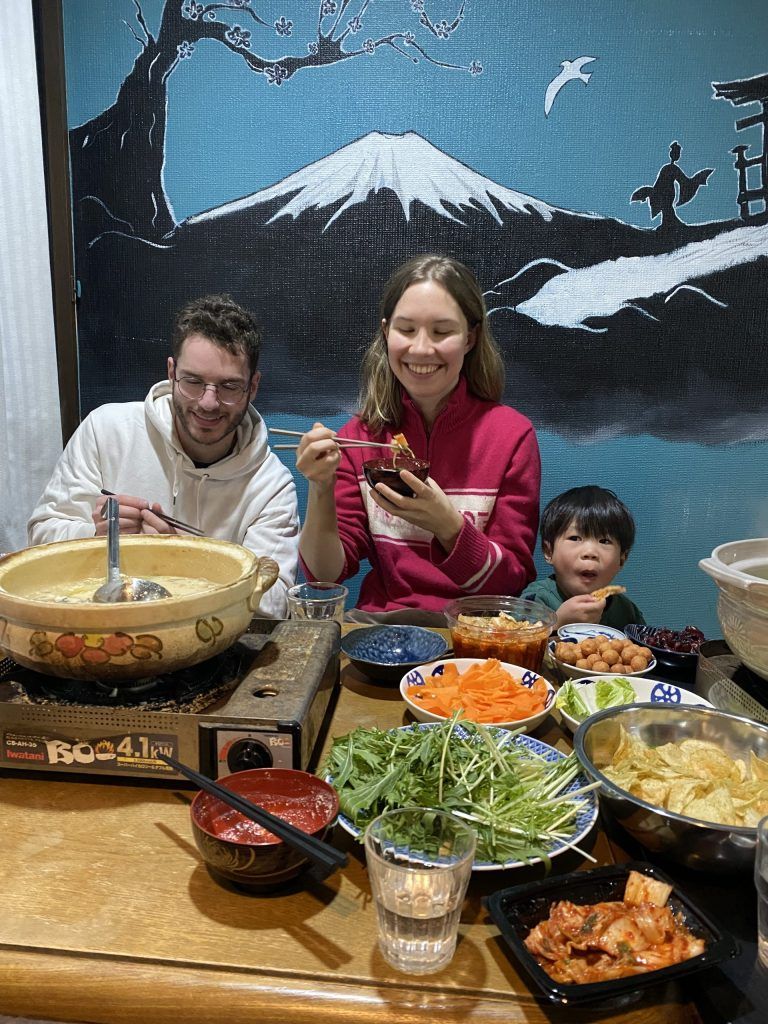
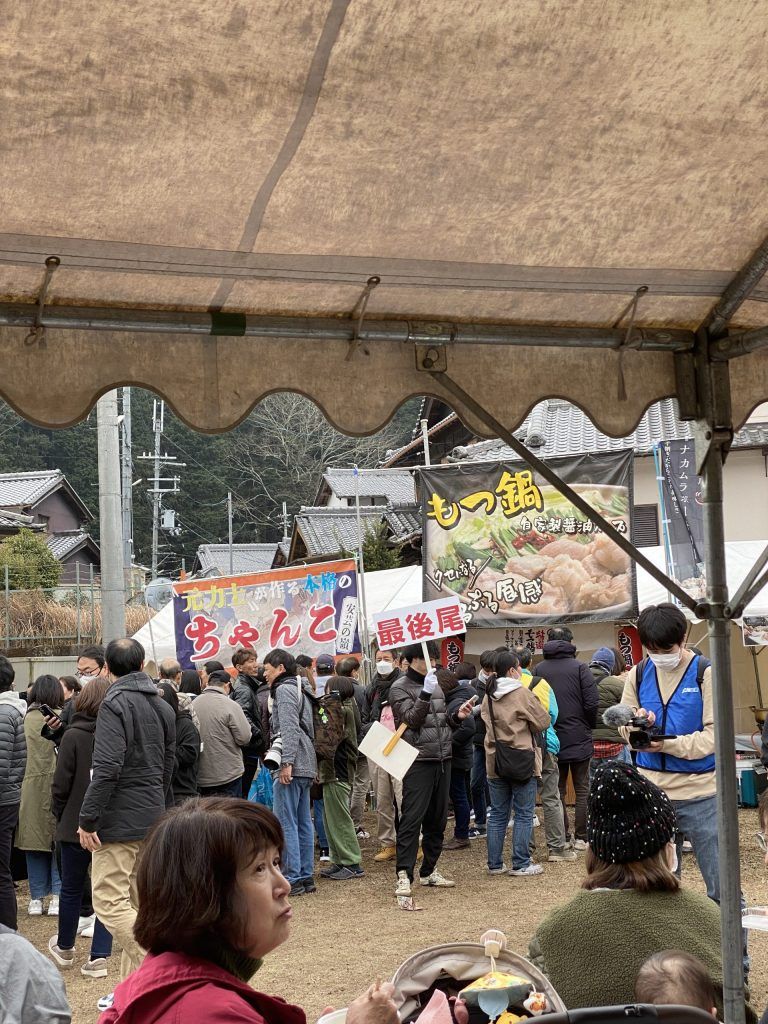
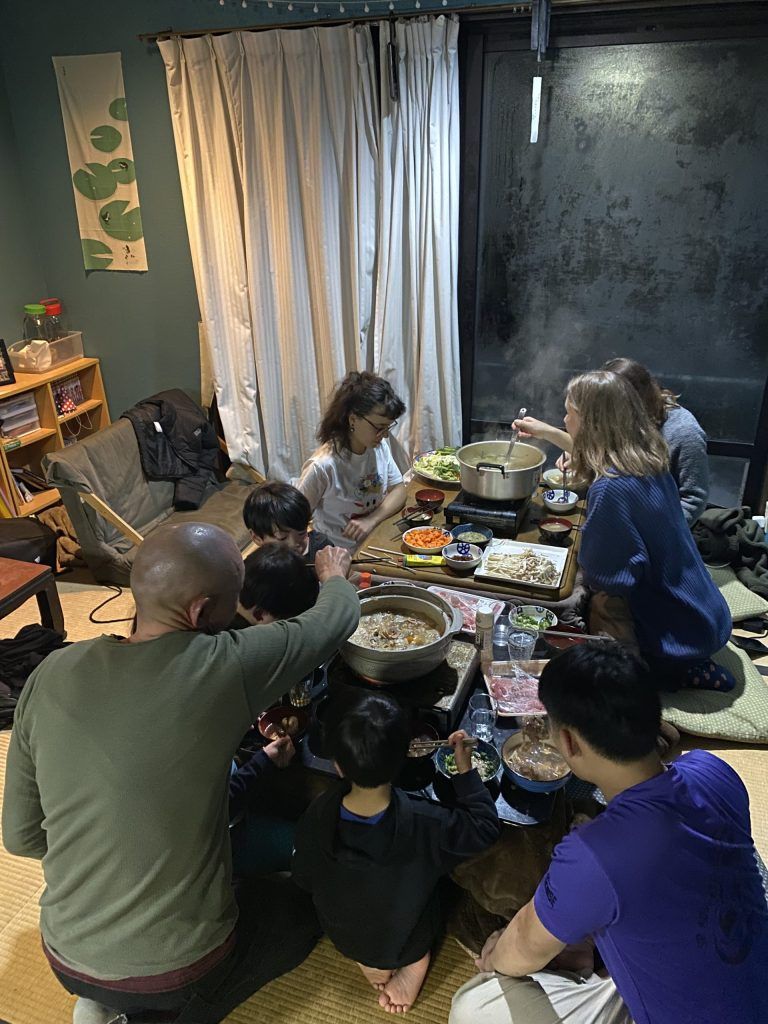
Workshops: Mochi, Wagashi, Temomi, and Pottery
As of recent, interns are now lucky enough to participate in workshops with local artisans—but fear not, assistant managers not only get to experience these workshops too, they also have the joy of co-hosting them! This winter, I had the chance to try mochi pounding with Toshi-san, wagashi making with Ishida-san, temomicha with Kenta-san, and a pottery workshop with Saito-san, where we made our very own chawan.

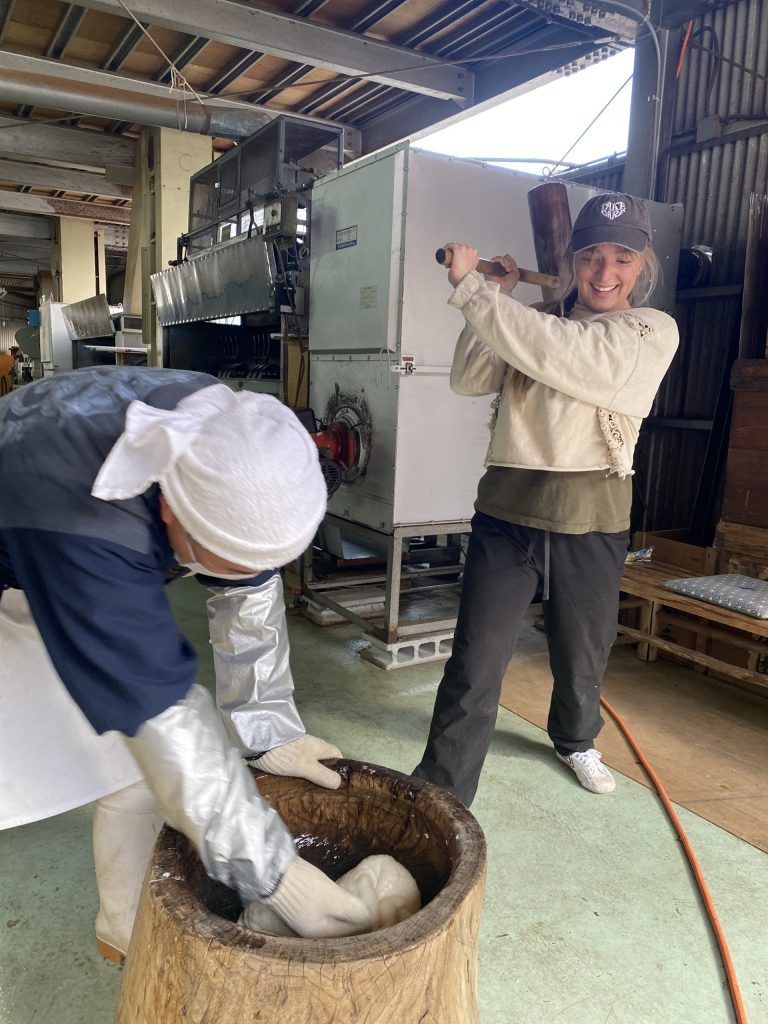
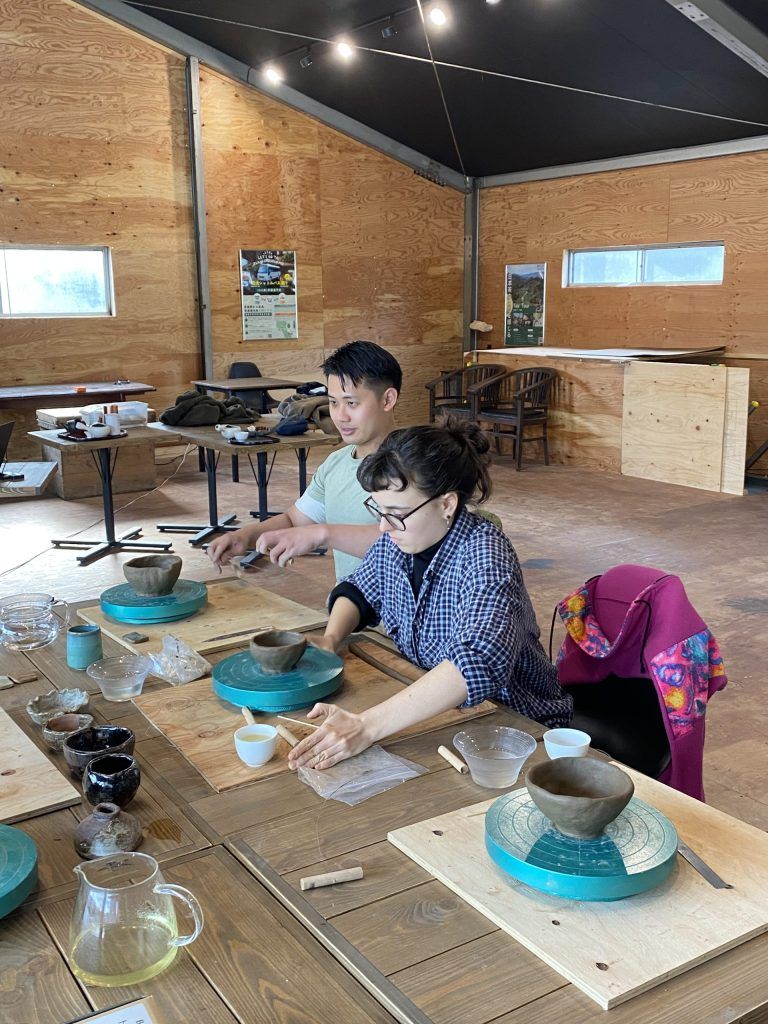
Ninja Village & Bouldering
What do assistant managers get up to after work, you might wonder? We’ve already covered plenty of shenanigan options, but the truly crazy ones (khem, khem me an Alix) also sneak off to the nearby ninja village in Koga for some training—before finishing up with a round of bouldering in Nara. Maybe one day we can harvest tea while throwing shuriken.
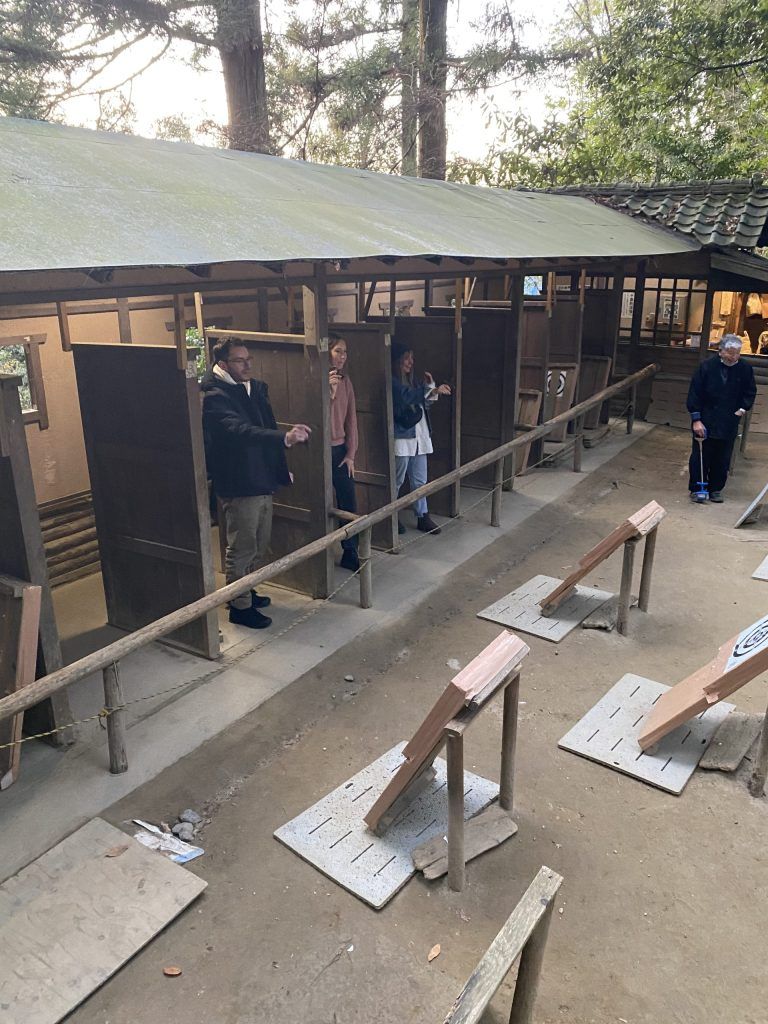
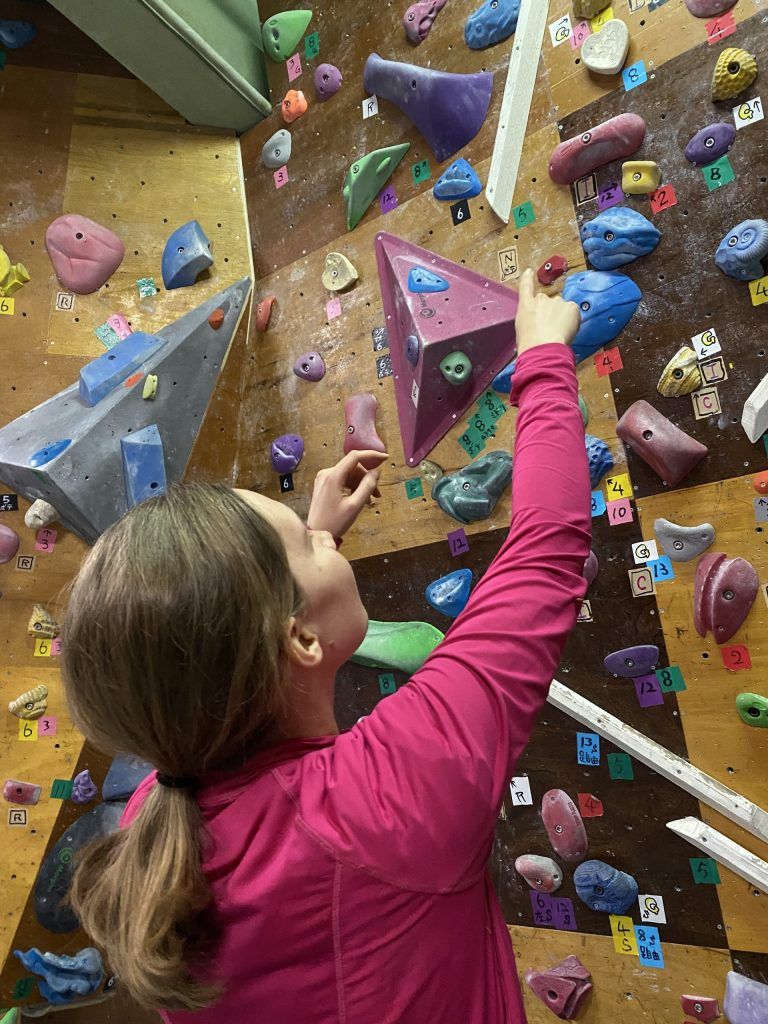
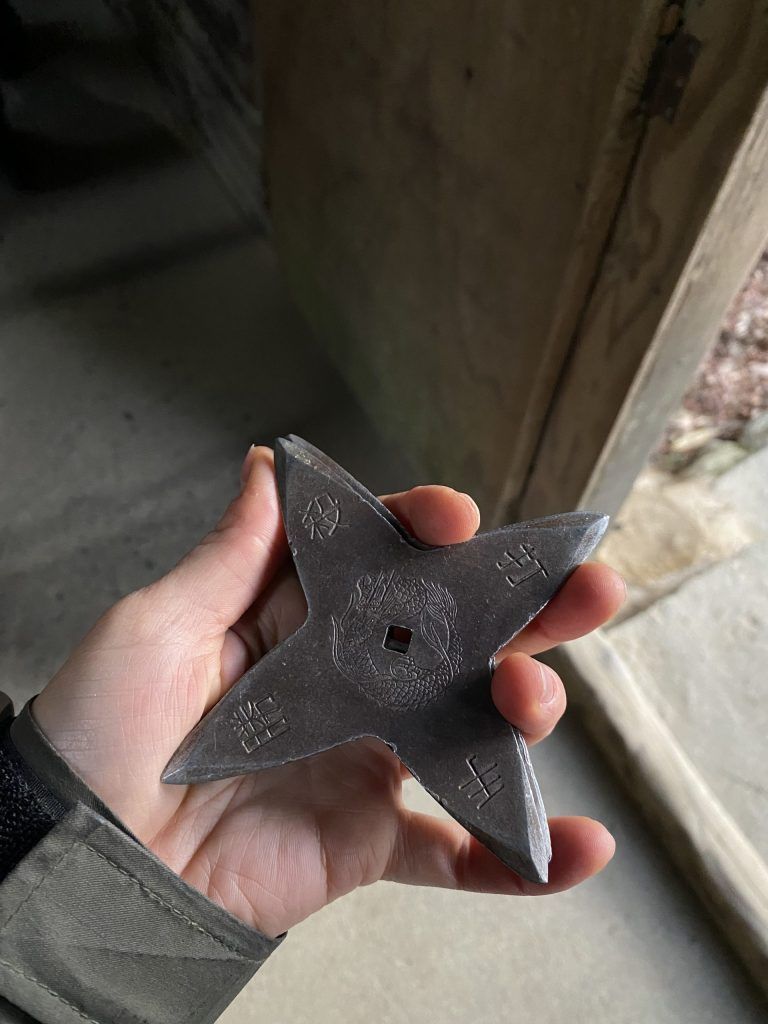
Ama Museum in Toba
On the Pacific coast of southeastern Mie Prefecture, the land stretches out into the sea to form the Shima Peninsula—also known as Ise-Shima—and shapes one side of Ise Bay. Just off the coast of Ise, sacred rocks called Meoto Iwa (the married-couple rocks) draw worshippers who come to pray. Along the peninsula’s rugged shoreline, groups of women continue a millennia-old tradition: plunging into the coastal waters to harvest pearls and the ocean’s edible treasures.
These women are the ama, divers who descend without oxygen tanks, much like their ancestors did centuries ago. They gather abalone, turban shells, sea urchins, and other sea life, as well as various types of seaweed. Exploring the amasisterhood felt truly magical—discovering the charms, dangers, and thrills of their extraordinary world through the lens of the Toba Sea-Folk Museum.
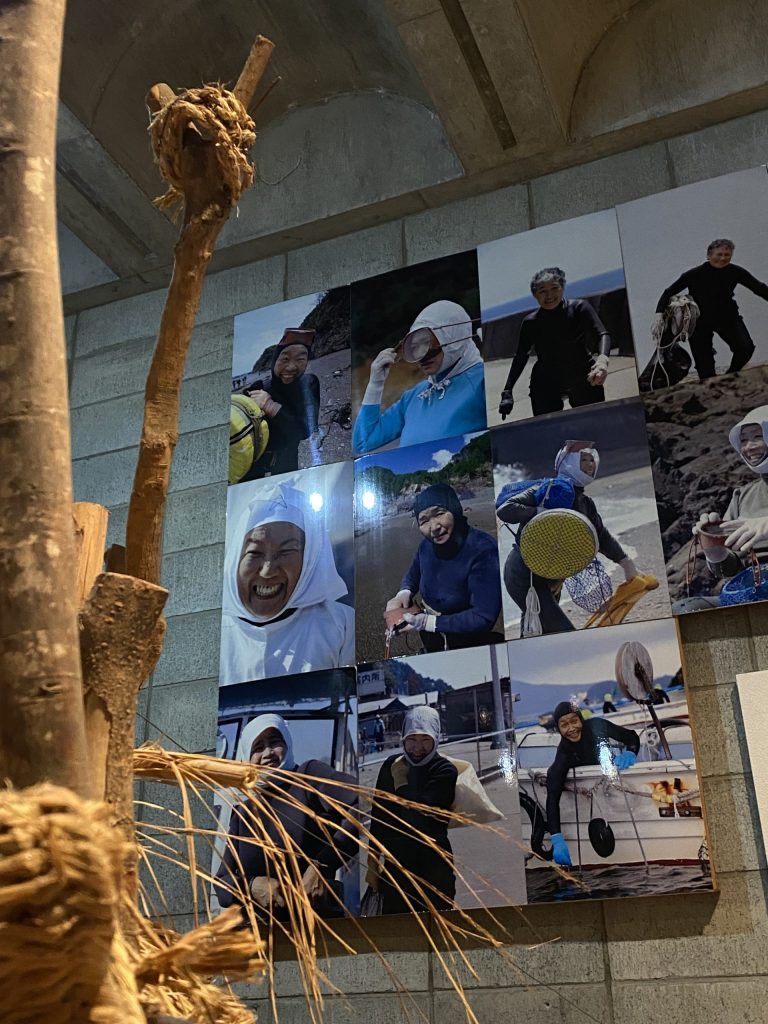

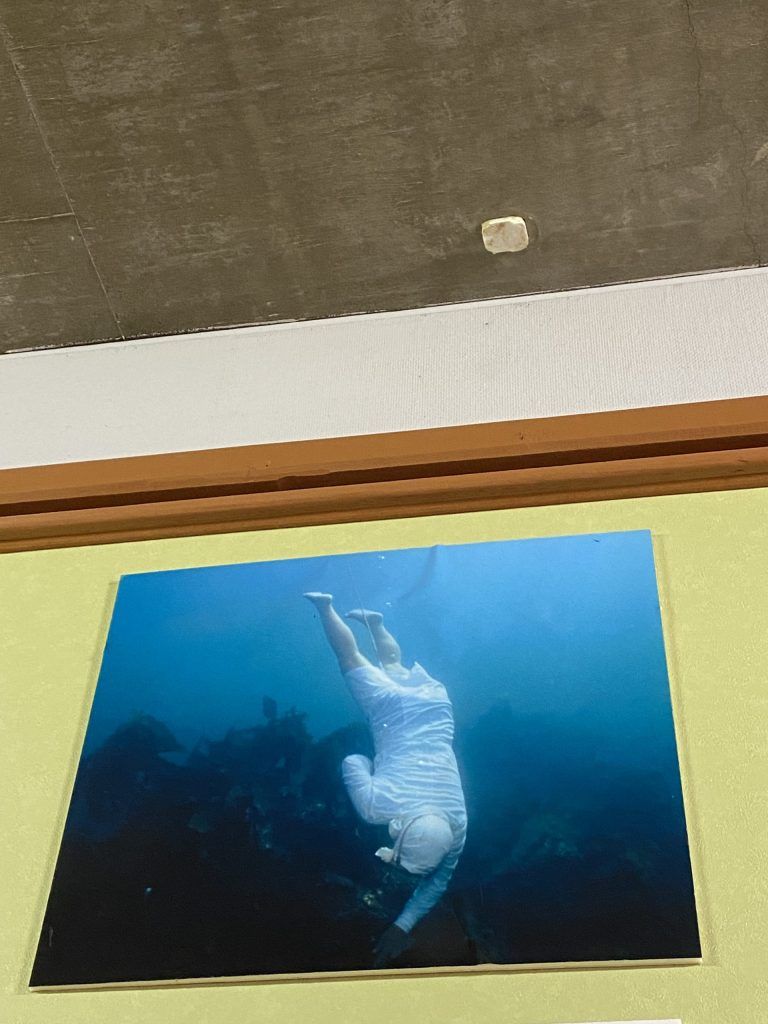
Winter Holiday: Kamikochi in Nagano
A close friend from Latvia visited me over the winter holidays, so we embarked on a comprehensive “Introduction to Japan” tour—which, as you might have guessed, featured plenty of tea fields and mountains. The highlight was definitely Kamikōchi (上高地) in Nagano Prefecture. Sometimes called the place where gods descend, Kamikōchi’s views of Hotakadake (穂高岳)—Japan’s third-highest peak—and Taisho Pond (大正池) truly evoke that feeling.
While staying at Guesthouse Raicho in Norikura Kogen, we discovered that the receptionist was a close friend of one of Obubu’s former interns. The moral of the story? Even if you venture into the middle of nowhere in the mountains, beneath a two-metre-thick blanket of snow, someone will know someone from Obubu lol.
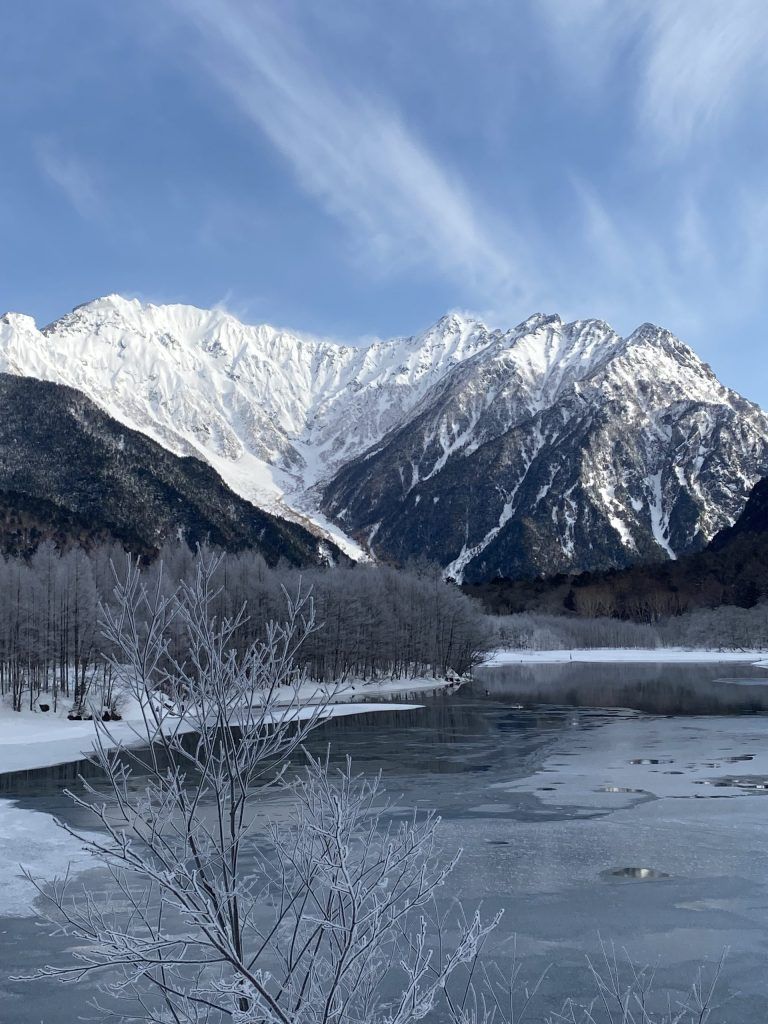

Yokohama Hayato Junior High School Event
For the fourth year in a row, our team had the pleasure of hosting an educational online tea event with students from Yokohama Hayato Junior High School, sharing the wonders of Japanese tea culture and farming. We explored tea cultivation, harvesting, processing, and brewing Kabuse Sencha, while also highlighting the importance of cultural exchange—with tea serving as a bridge that connects people and traditions across the world. When I was an intern 3 years ago, I joined this event also with Matsu-san and my co-intern Hannah. It was very special to do so once again this year!
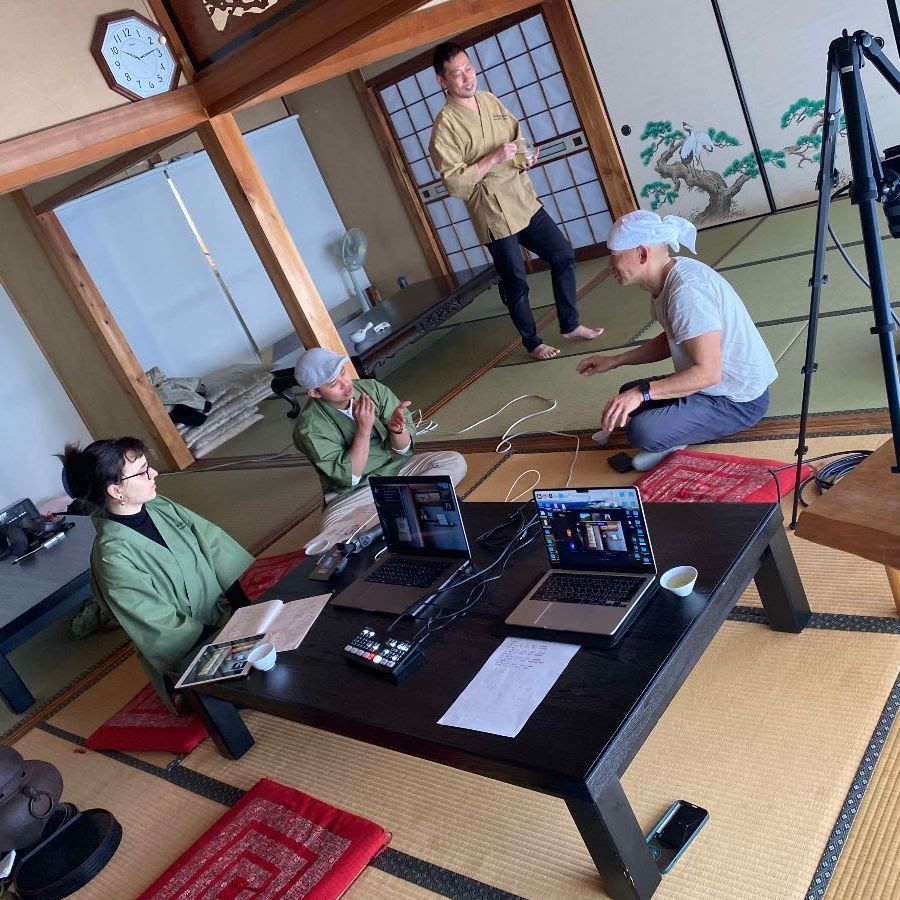
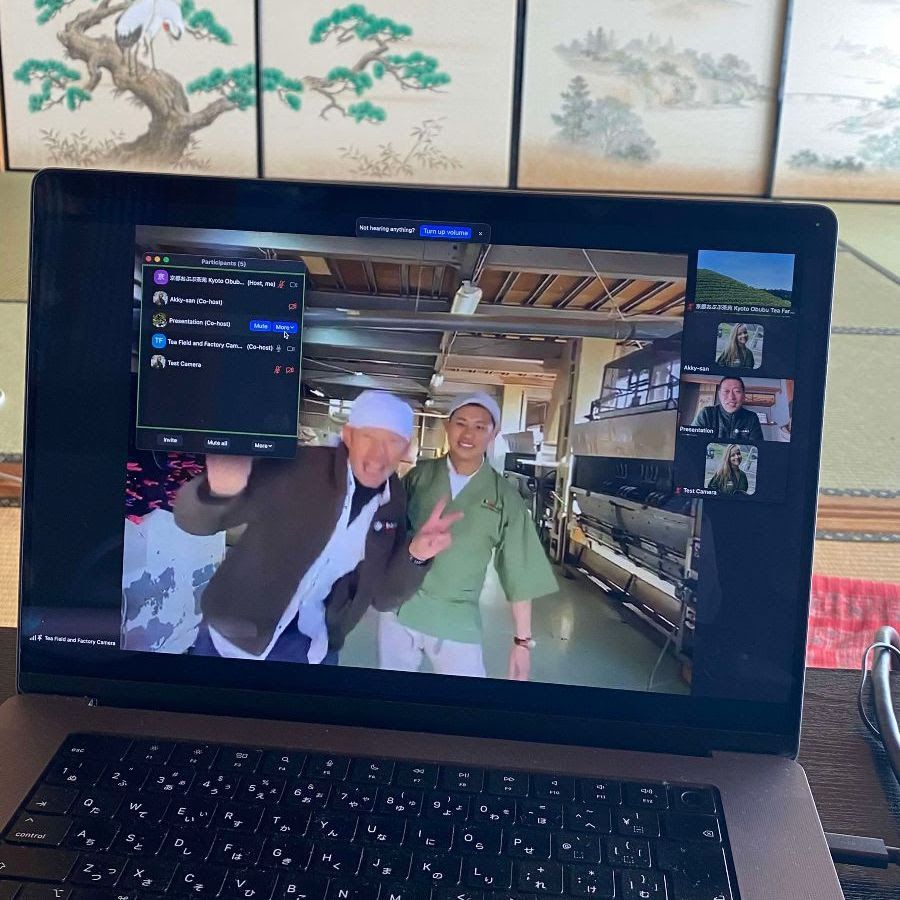
Soni Kogen with Miwako-san and Sakura-chan
By now, surely we all can agree that Miwako-san’s Shiba Inu friend, Sakura-chan, is everyone’s highlight of the day whenever she visits. Luckily, both Miwako-san and I are huge fans of wildlife outings, so we went on one of her favourite walks in the Soni Highlands of Nara Prefecture. We enjoyed tea together, admired the rocks, and took in the stunning landscapes. 10/10.

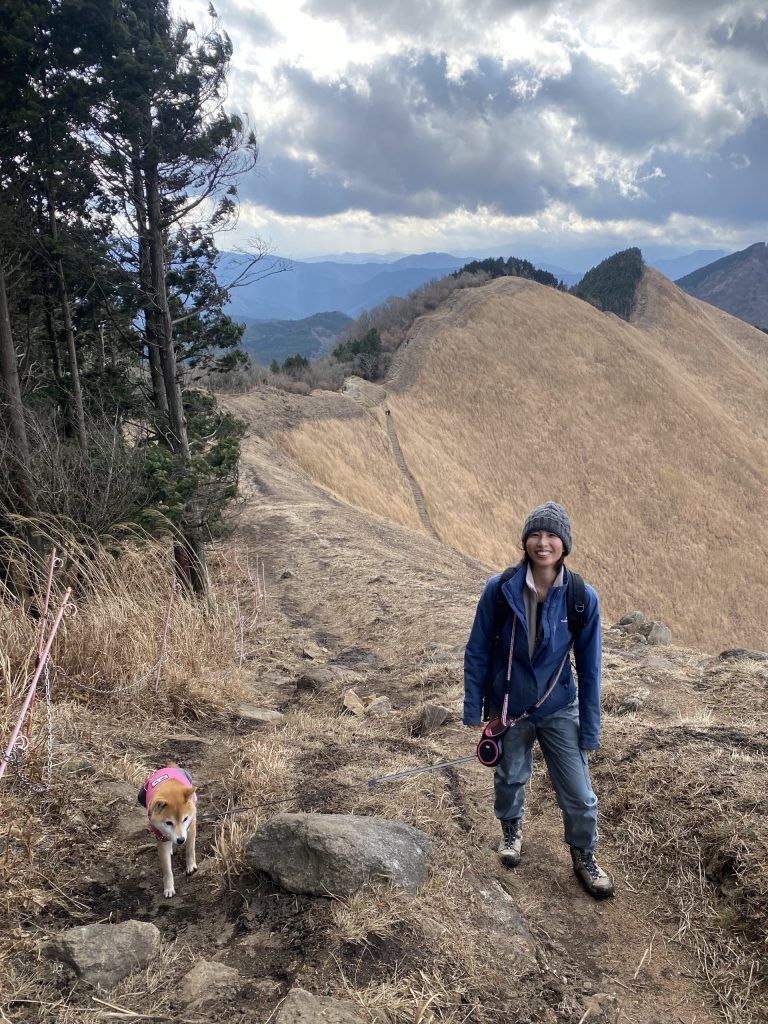
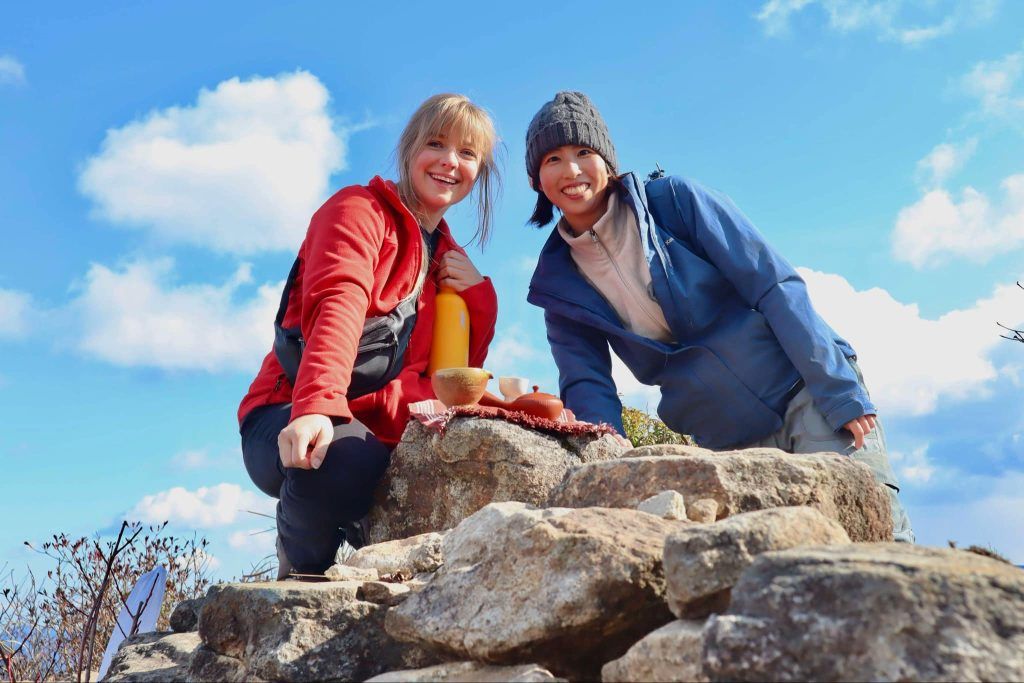
Construction & Hojicha Fridge
Winter typically has a few construction jobs going on, maintaining the surrounding facilities and buildings. This time, we undertook a major spring cleaning project—the Hojicha Fridge (which, despite its name, stores much more than just hojicha!). After emptying and reorganising shelves, replacing flooring, and installing new storage, the space was transformed into a sparkling, well-organised inventory system—all thanks to the masterful planning of Kayo-san, George, Pau, Hiro-san, and Miwako-san! Between tea tours and farming, interns Eva and Joshua also have been hard at work building new rooms at the Obubu House and in the neighbouring building, now called the Kyobancha house since in the past, it used to be a Kyobancha factory.

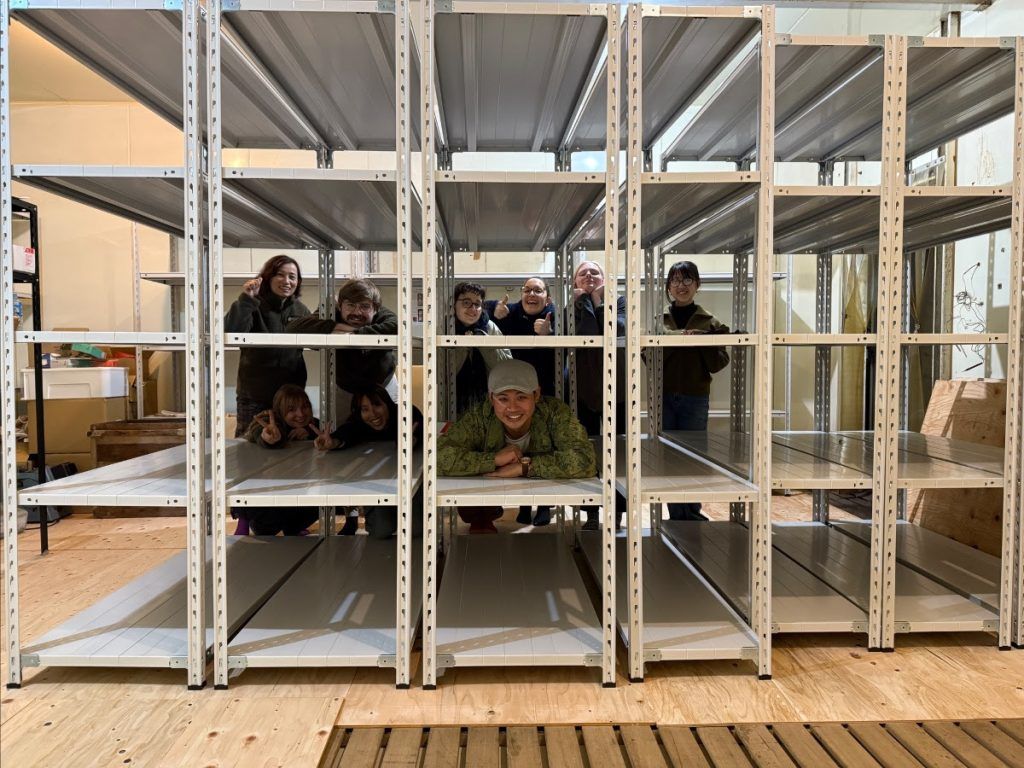
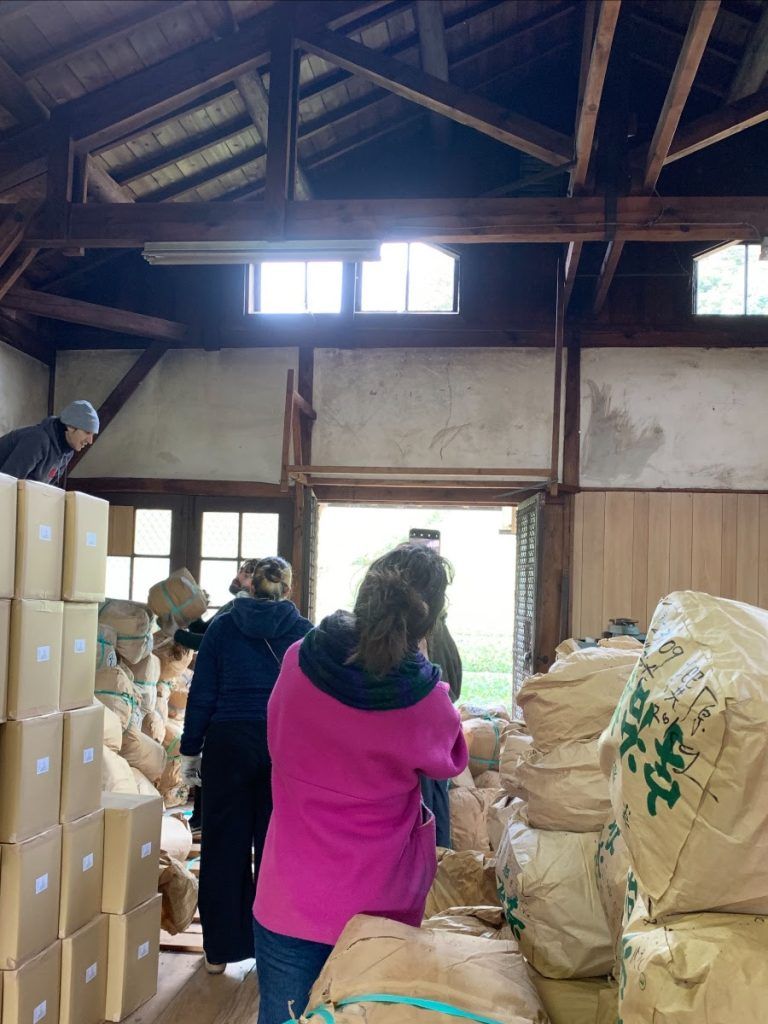
Minagoyama with Alix, Eva, and Joshua
February brought a beautiful snowstorm to Kansai, blanketing the landscape in white. Seizing the moment, together with Eva, Joshua and Alix, we hiked to the top of Mt. Minako, the highest one in Kyoto prefecture, with one mission in mind: to enjoy tea at the peak of winter! After plenty of slipping, snowball fights, and lots of singing (yes, Joshua), I set up my brewing station (or TJ deck) on a tilted tree, serving Sencha to warm everyone up. On the way down, Alix prepared soothing bowls of Matcha for everyone, putting her Urasenke Sado tea ceremony skills to use. Not all Obubu experiences happen to be tea-related (albeit most of them are)—Joshua saw snow for the first time! A memory surely to last a lifetime for all of us. After the crazy snowstorm winter wonderland sceneries, we went to Otsu to drink some more tea in a local tea shop Seiseido.
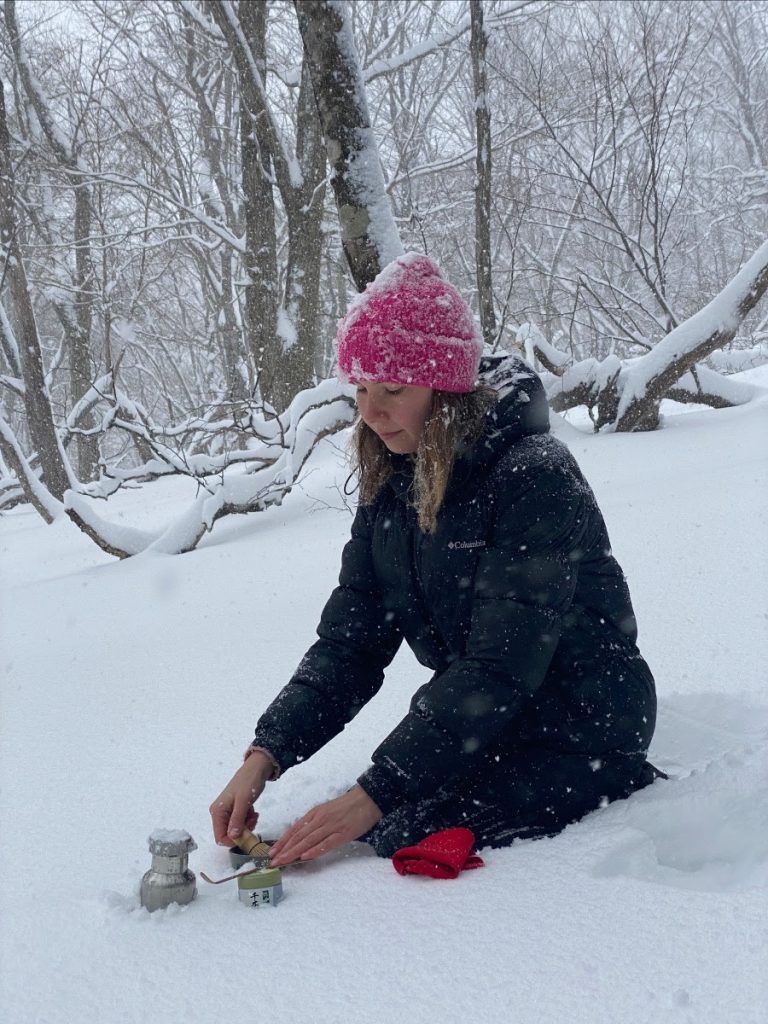
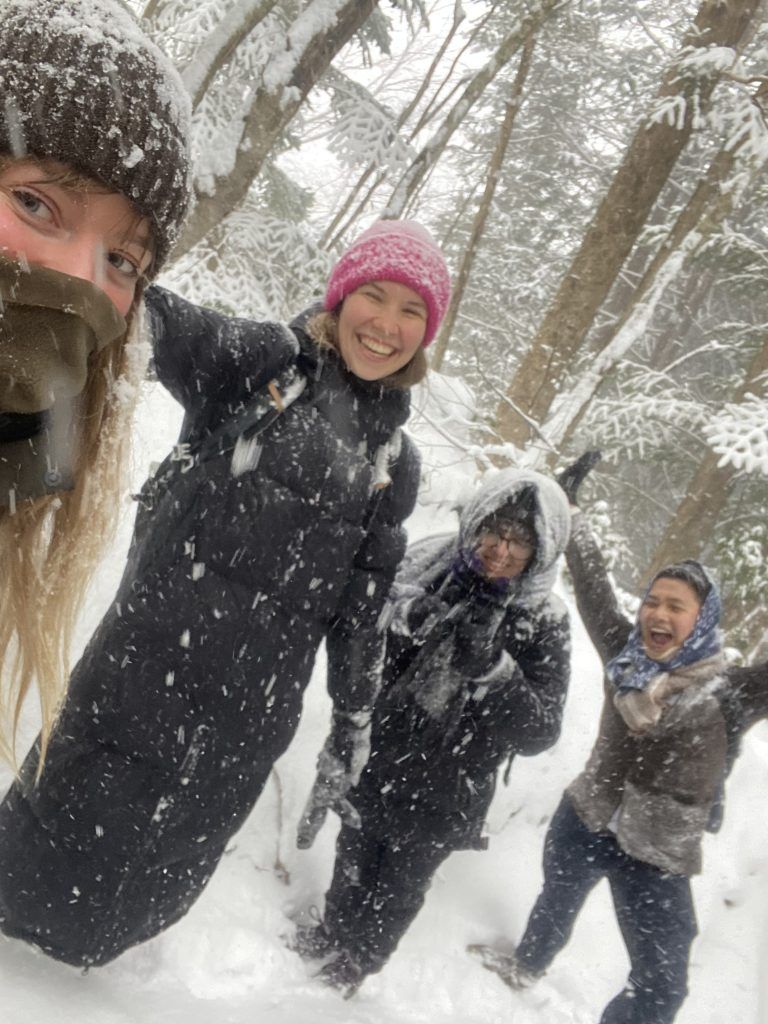
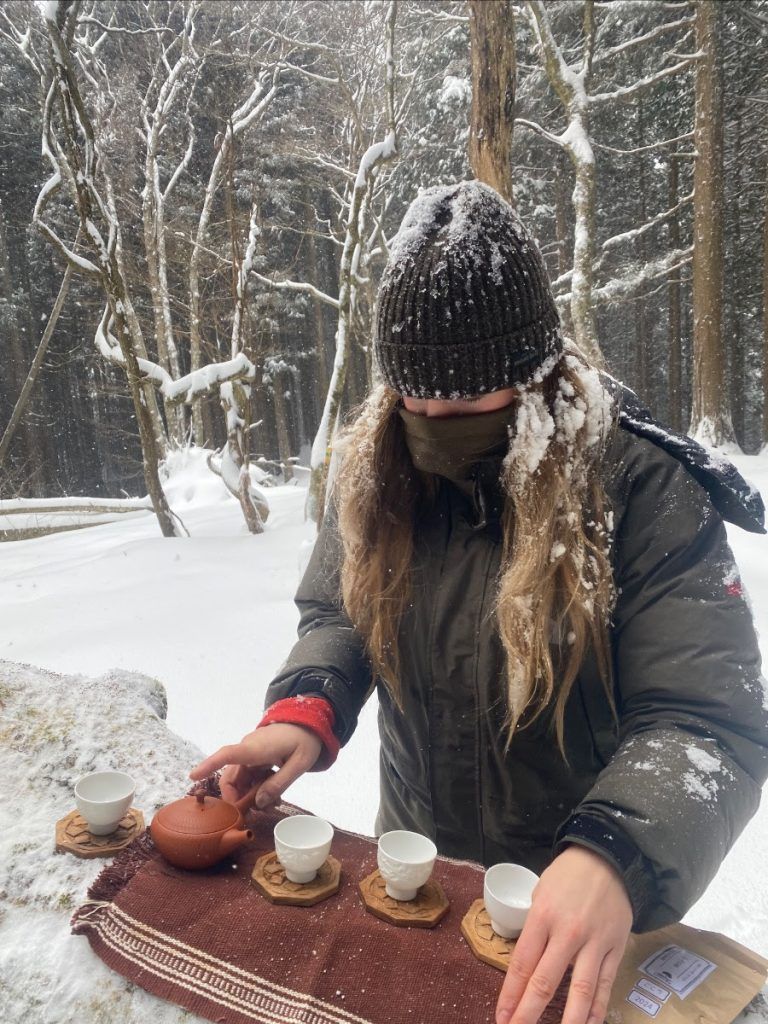
Chakabuki Competition at Obubu, as well as in Uji
To prepare for the upcoming Chakabuki (tea tasting) competition in Uji, Akky-san hosted a practice round with Obubu staff and interns. Participants tested their skills by identifying teas such as Heavenly Drop Gyokuro (Gokou), Sencha of the Earth (Zairai), Kabuse Sencha (Yabukita), Sencha of the Forest Glow (Sayama Kaori) and Sencha of the Spring Spring Sun (Yabukita). Even though we drink these teas daily, the competition’s challenging brewing conditions made it a true test of skill. This time I did manage to win with 23 points out of 25, but to be fair, the next Obubu chakabuki that we have done, I performed rather poorly haha, hence, let’s attribute this to beginner’s luck.
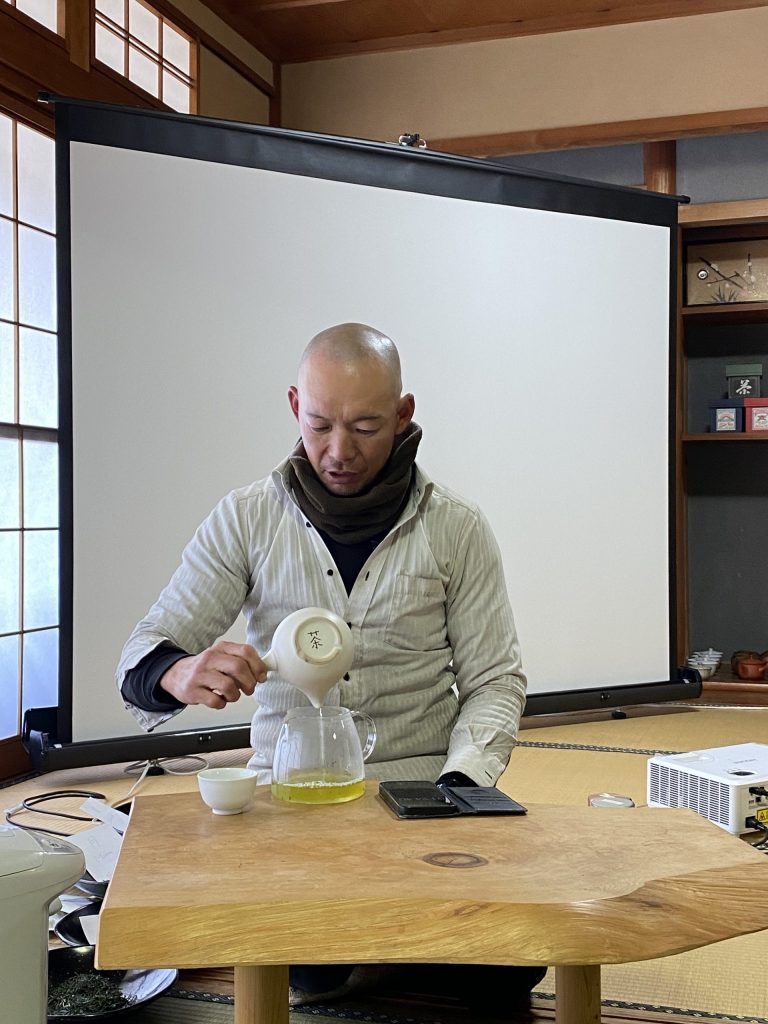
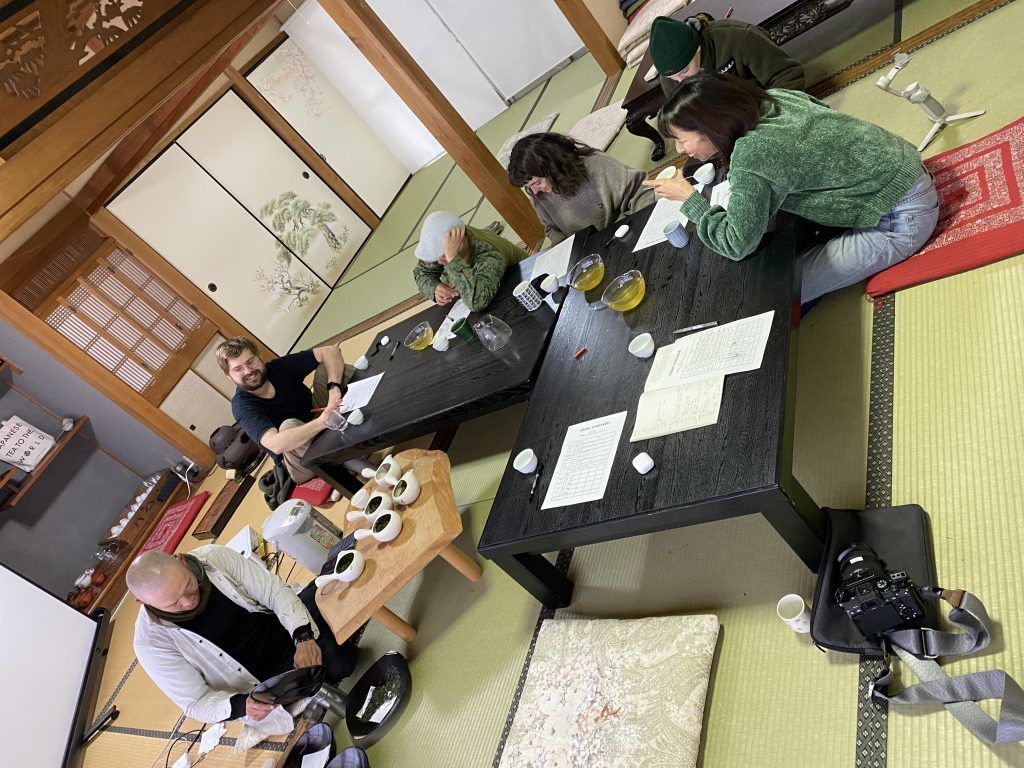
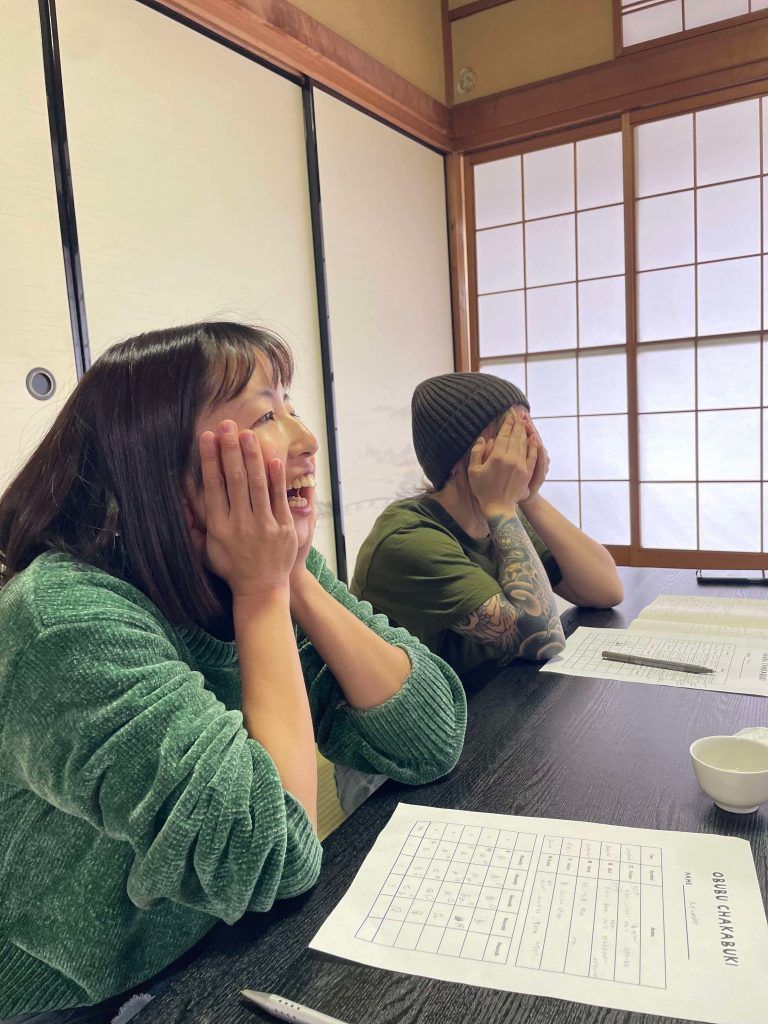
After the practice rounds at Obubu, Akky-san, Alix, and myself competed in the Uji Chakabuki competition on February 22nd. The event was split into two groups: 30 professional competitors (Nihoncha Instructors) and 30 general participants. Akky-san placed 4th among the pros, while Alix secured 4th place and myself 9th place in the general category.
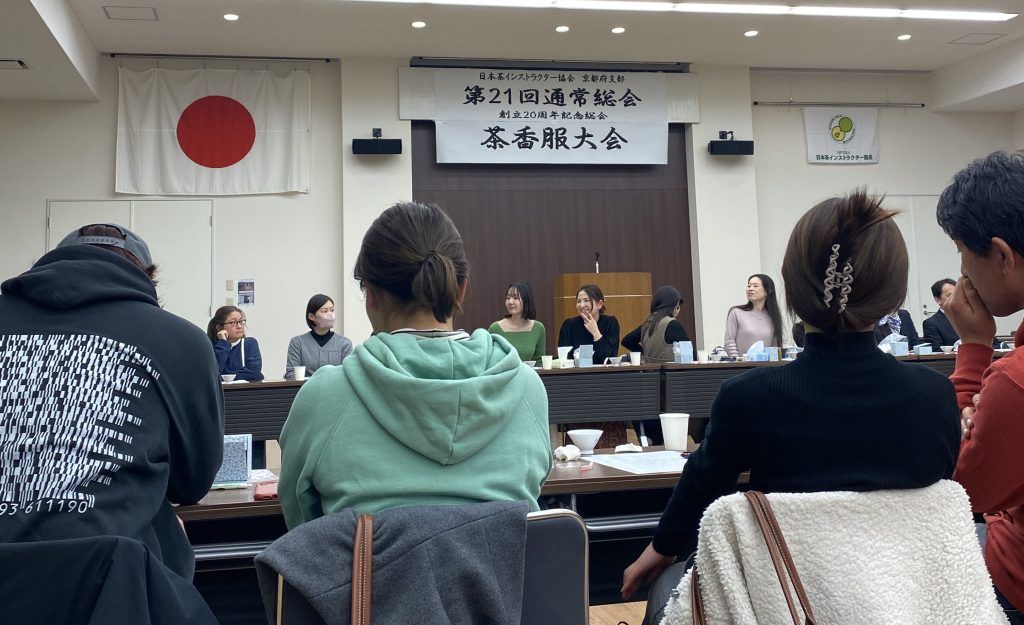
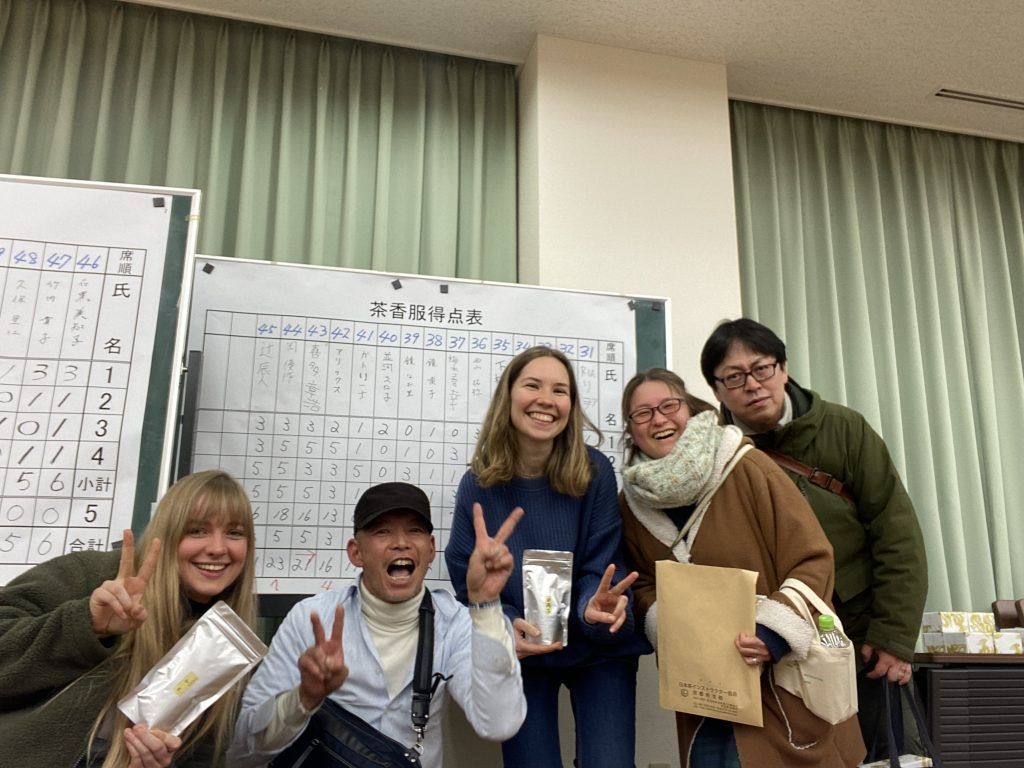
Graduations & Welcomes
As some former interns and assistant managers already know, life at Obubu can be a rollercoaster. Meeting wonderful people from all over the world is always magical, but when you’ve bonded with those special individuals over several months, the time inevitably comes for goodbyes. We are fortunate to forge friendships that transcend borders and cultures, yet parting can often be the hardest part.
This winter, we welcomed new interns Eva (Slovenia) and Joshua (Singapore), as well as new assistant managers Mia (USA), Nicole (New Zealand/Australia), Marilena (Italy), and Tran (USA). At the same time, we experienced the particularly bittersweet graduation of my senpai assistant managers, Alix and Mac. The days that follow such farewells can feel strangely empty, as you adjust to life without the people you spent nearly every day with—sharing countless special memories.

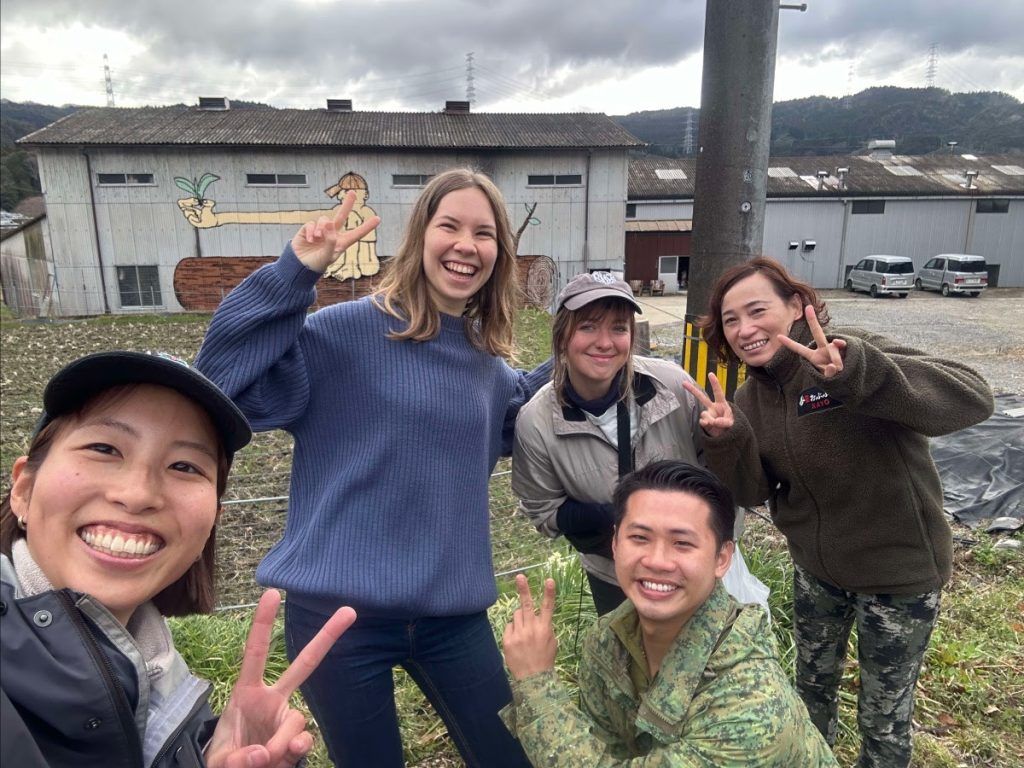
Sweet Sakura Tea Making
As the sakura (cherry blossom) season steadily approached in February, we began making Sweet Sakura Tea! This is quite a unique winter experience, as the process starts with pickling the sakura flowers for two weeks. After that, we remove the salt by gently shaking the flowers in strainers. Next, we carefully wash the flowers several times to further remove the salt. Then, we drain and gently squeeze out the water, delicately separating each flower to preserve its shape before placing them on trays lined with paper towels. Finally, the flowers dry for two to three weeks before being mixed with sugar.
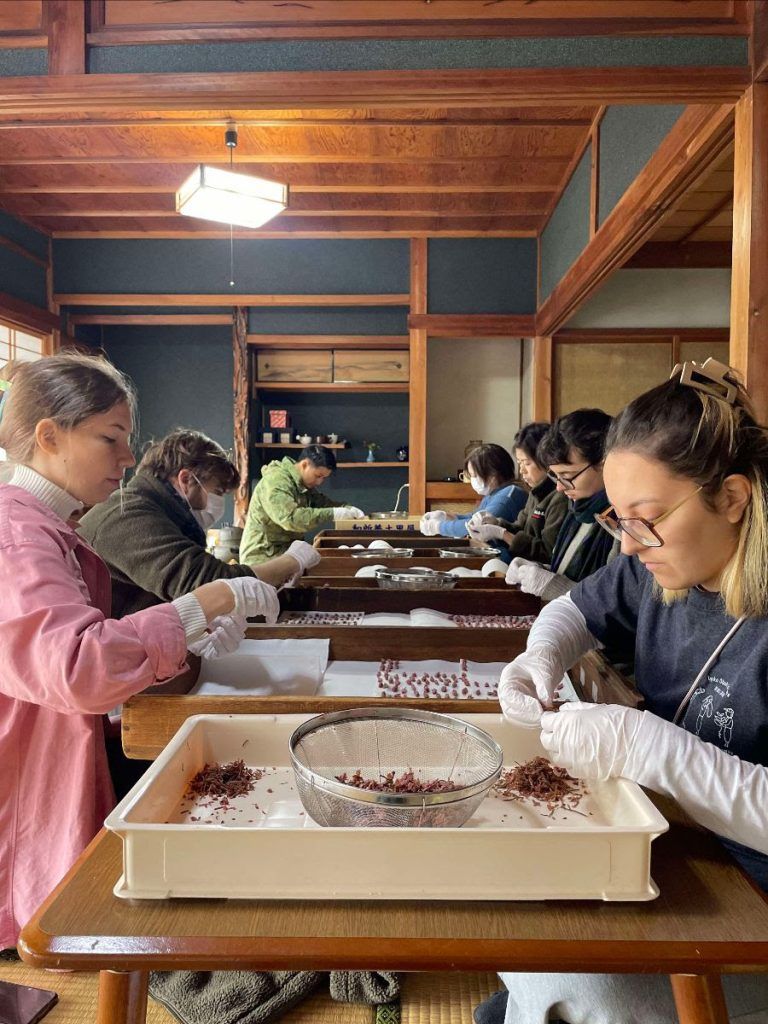
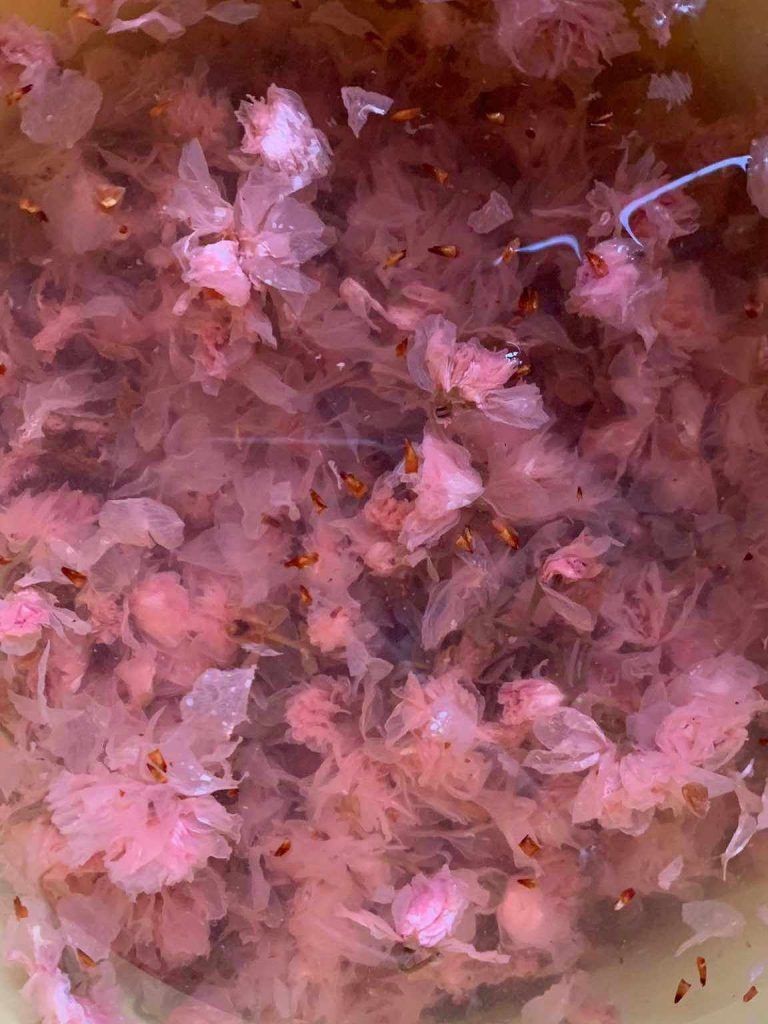
Cheese & Photography Lounge
Nearing the end of her year as an assistant manager at Obubu, Alix presented one of her two personal projects: Cheese and Tea Pairings! She took us on a journey through her professional experiences with cheese, what cheese is, and how to correctly slice cheese (Cheese: Nani Kore?!). At the end, we tasted delicious French cheese and experimented by pairing them with different teas, including Tencha, Sakura Sencha, and Pine Needle Wakoucha. Mac also presented her assistant manager project: a series of gorgeous black and white film photos taken during her time here while playing a recording of Matsu-san playing on piano “Merry Christmas, Mr. Lawrence” by Ryuichi Sakamoto. The real soundtrack of Obubu House throughout decades.
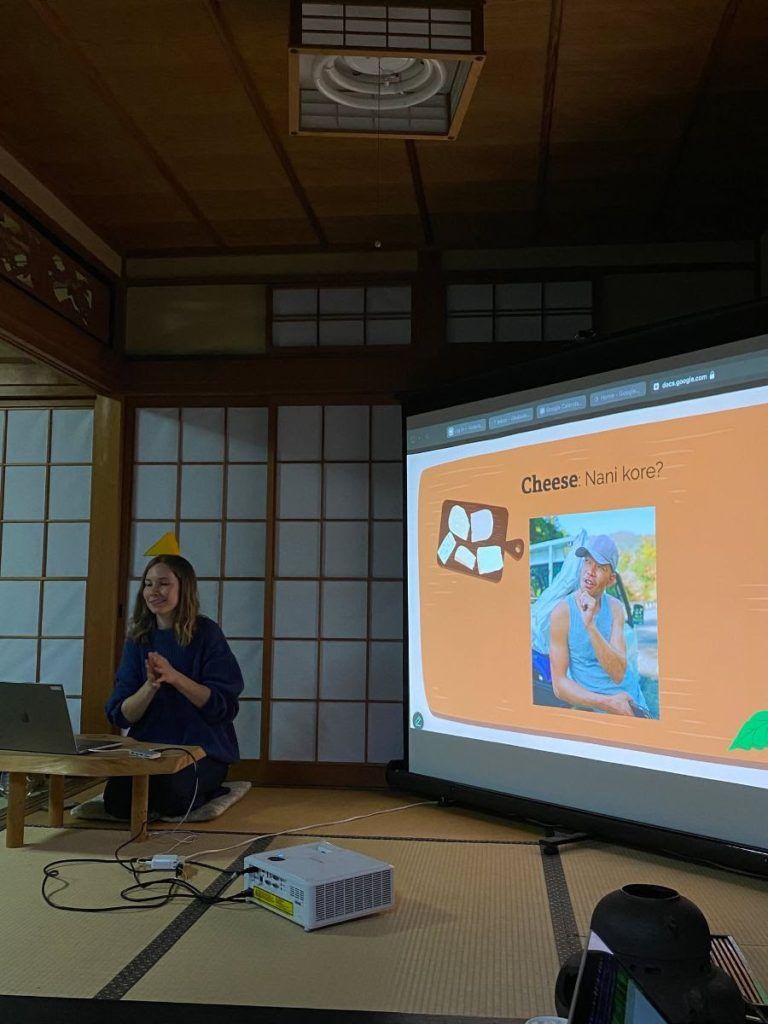
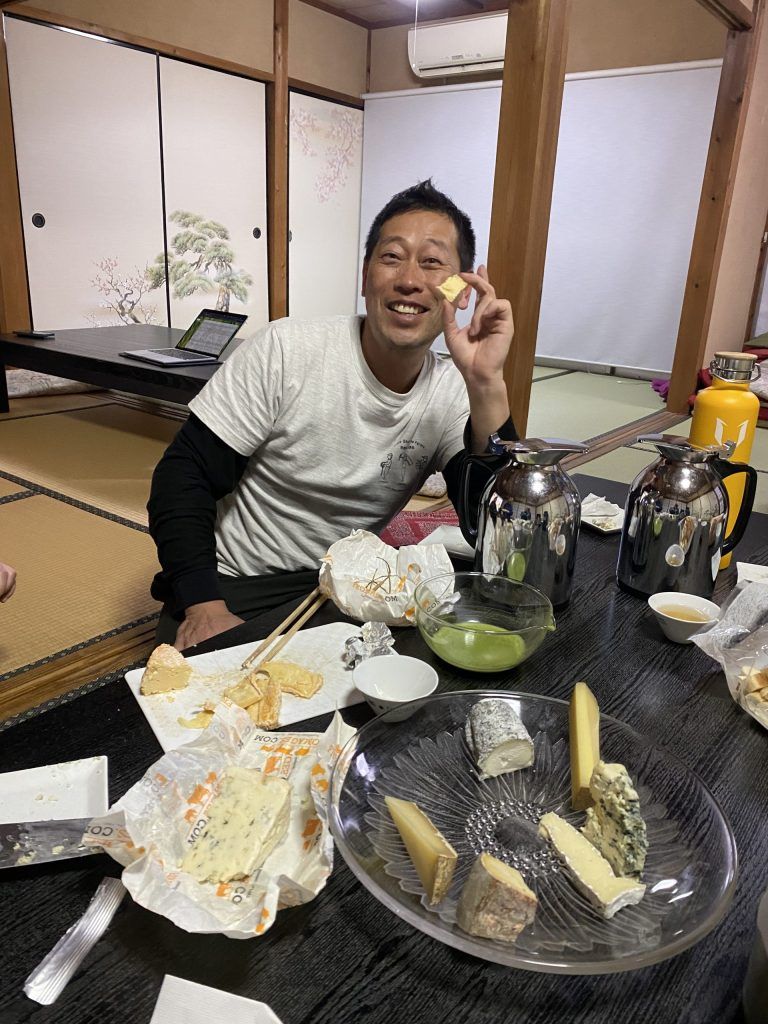
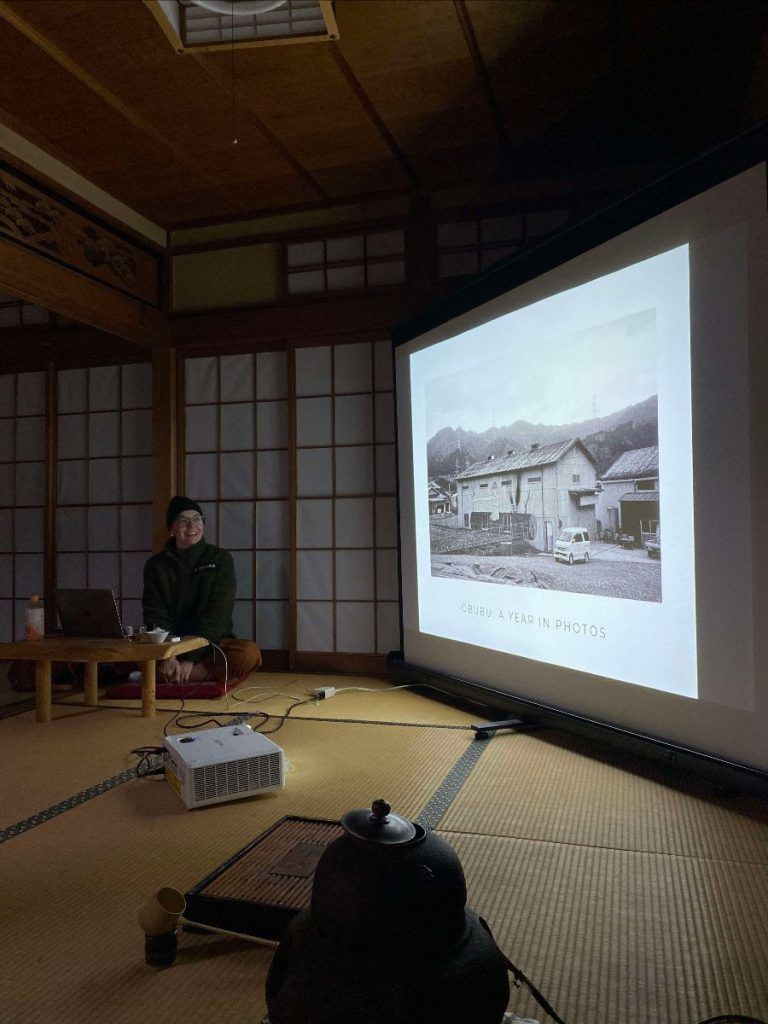
Onomichi, Hiroshima: TEA FACTORY GEN
Earlier I mentioned how I first met Genki-san of Tea Factory Gen in Taiwan—a meeting that blossomed into a series of collaborations and a lasting friendship. So, when the opportunity arose, Kayo-san, Akky-san, the kids, and I finally visited him in Onomichi, Hiroshima. TEA FACTORY GEN is located in Sera, Hiroshima, where 60-year-old zairai native tea plants are cultivated and processed without fertilisers or pesticides, resulting in truly unique teas. The Sera region is well-known for its rich agricultural heritage, producing pears, matsutake mushrooms, rice, and other crops. Situated at an altitude of around 400 metres, the area also experiences significant snowfall.
Tea cultivation began to flourish here about 90 years ago, with Hiroshima becoming famous for its “Sera tea.” However, from around 1990, the tea industry in Sera went into decline. When Genki-san started growing tea again in 2016, many tea fields lay abandoned, and the processing factory was almost in ruins. Originally called the Tsukushi Tea Factory, the processing plant was built roughly 70 years ago. Historical documents tell us that sencha production in the region began in the Taisho era (1912–1926), and the Tsukushi Tea Factory was constructed in 1955, during the peak of tea production in Sera.
Though we didn’t have time to visit Genki-san’s tea fields or processing factory this trip, we were fortunate to visit two of his tea shops: TEA STAND GEN, tucked away in an old house in the backstreets behind Onomichi’s Kaigandori, and TEA STAND GEN YAMATE, also located in Onomichi. His teas are definitely worth a try! And Onomichi feels like a vintage artistic town with plenty of temples, old streets, and a seaside port — absolutely stunning!
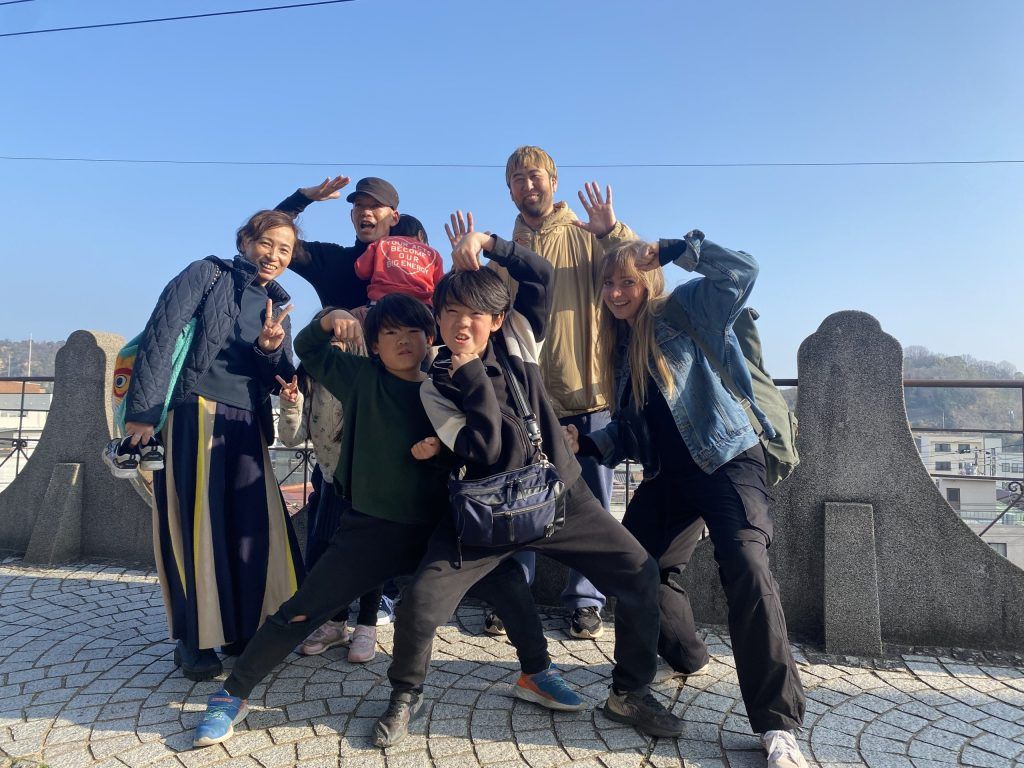
Kyobancha Harvest
On March 7th, we had our annual harvest for Kyobancha in Aoi Mori, the Okumidori cultivar part of the tea field. This was the first harvesting experience for our interns Eva and Josh. The leaves we harvested are bancha leaves, so they are quite coarse and big. After harvest, they are steamed and roasted to create Kyobancha’s characteristic delicious smoky and woody flavours, sweet taste, and very low caffeine content, hence, its nickname – baby’s tea. Fun fact: Josh was one of the tea club members together with Mike, who named this tea field in 2022 during a naming contest, so it was extra special day for him to harvest here!
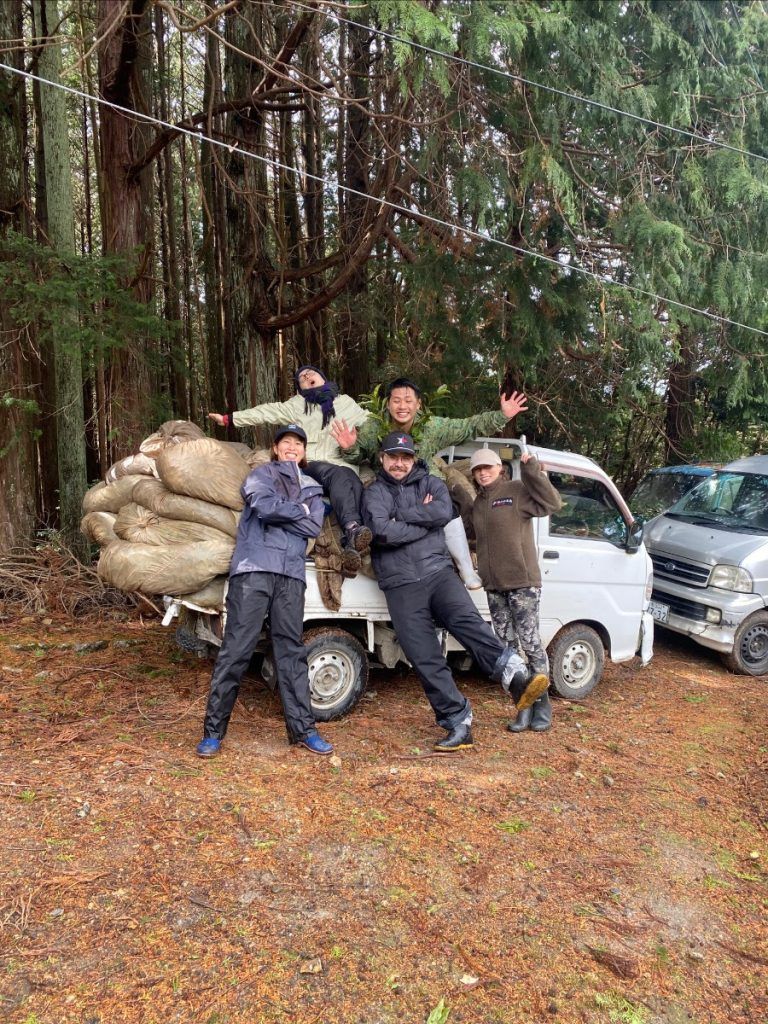
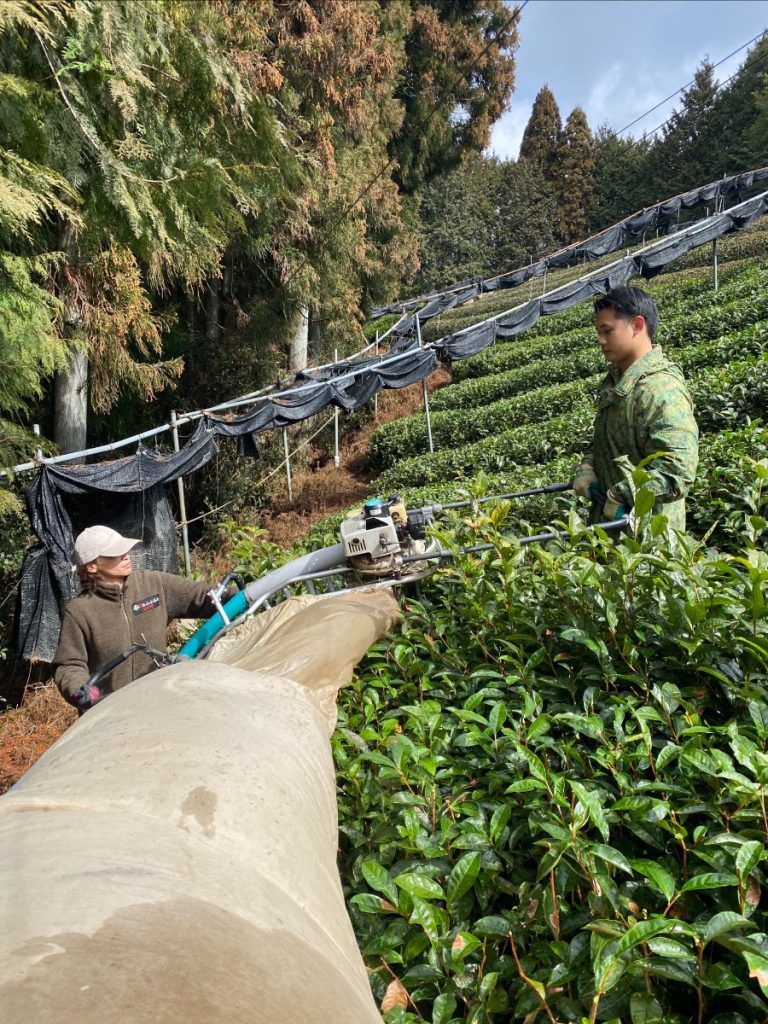
Hand-Rolling Competition in Uji
After all of the practice rounds last month with the Wazuka Tea Hand-Rolling Preservation Society, together with Akky-san, Miwako-san, Pau, and Alix, we headed to the Uji Tea Hand-Rolling Competition. There were four teams from Wazuka, three from Uji, three from Minamiyamashiro village, and one from Kyotanabe. Everyone was rolling shaded Gokou cultivar leaf material from the famous traditional Uji tea producer Yoshida Meichaen, whom we were lucky to visit at the end of the March to learn how to build traditional bamboo structures for shading tea with rice straw. The team that Pau was supporting got the 1st place, Akky-san’s team placed second, and Miwako-san’s group placed the 5th, which means that Wazuka teams got the 1st, 2nd, 3rd, and the 5th places! We are so happy that our village’s tea passion shined that day! I was primarily filming material for my assistant manager project film about temomicha, while Alix craftily took photos of all of us.
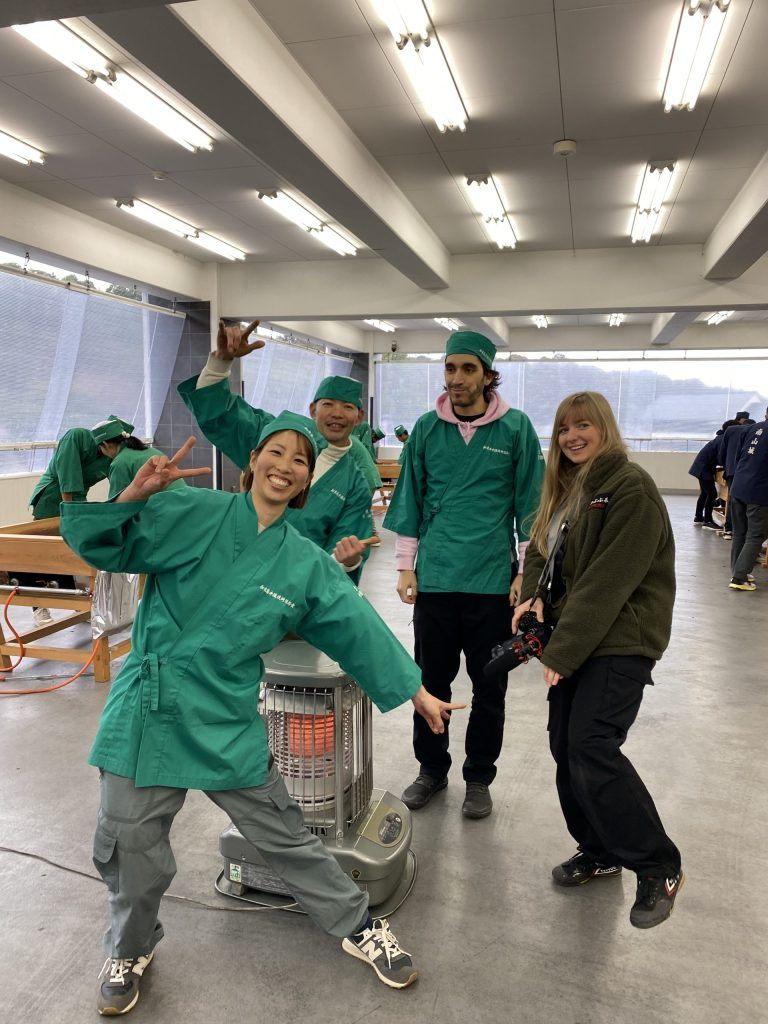


Quite eventful, huh?
I hope this lengthy read wasn’t too tedious (wow, you actually read it all!!!! sank youuuu veriii machiiii) and that it offered a nice glimpse into life at Obubu and the rural rhythms of Japan through the eyes of a prospective tea farmer. Especially if you’re considering applying for the internship or assistant manager position, I hope it gives you a flavour of what to expect.
See you in the next blog, where I’ll share one of the most exciting times of the year—the first harvest of spring!

